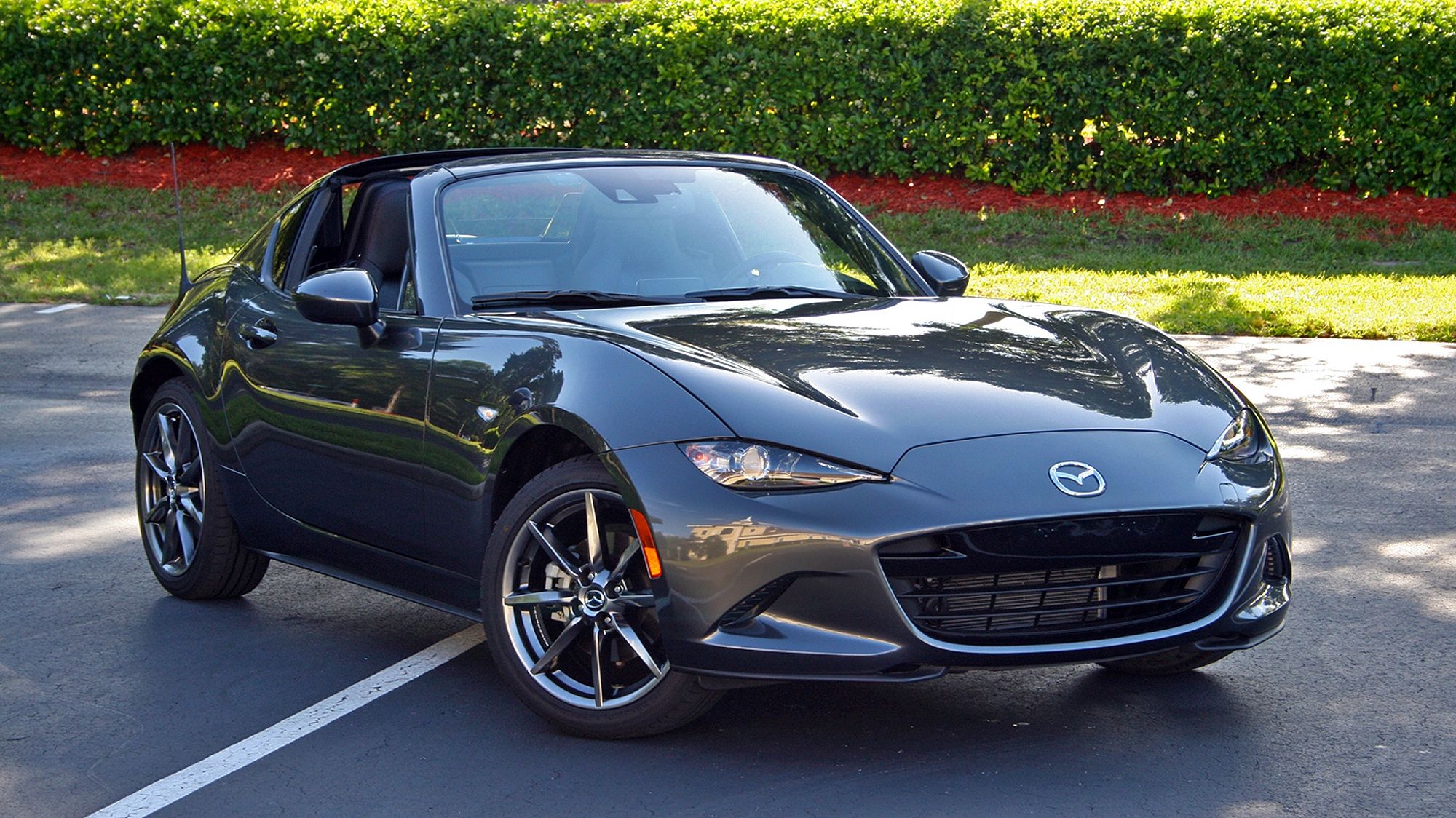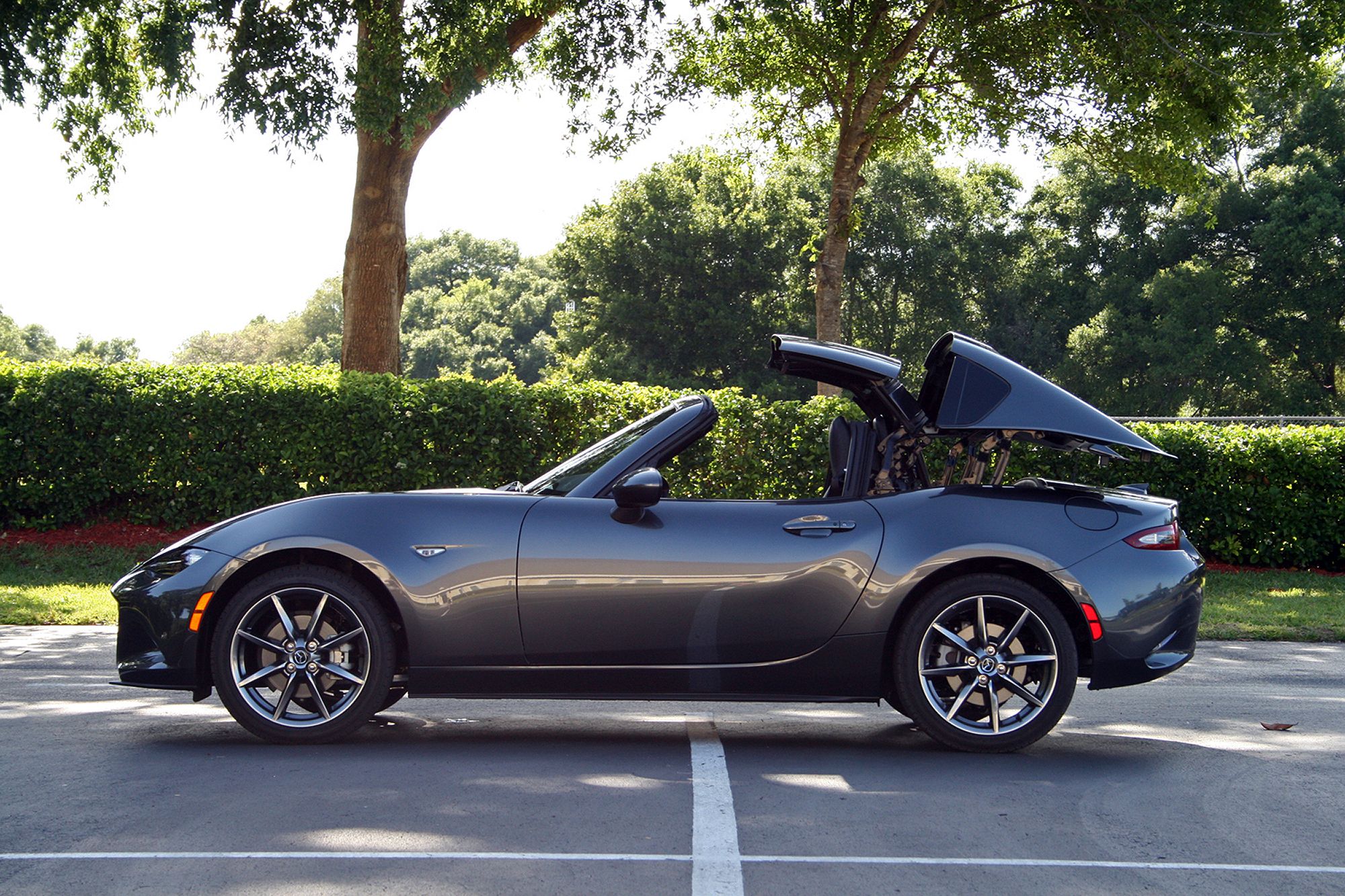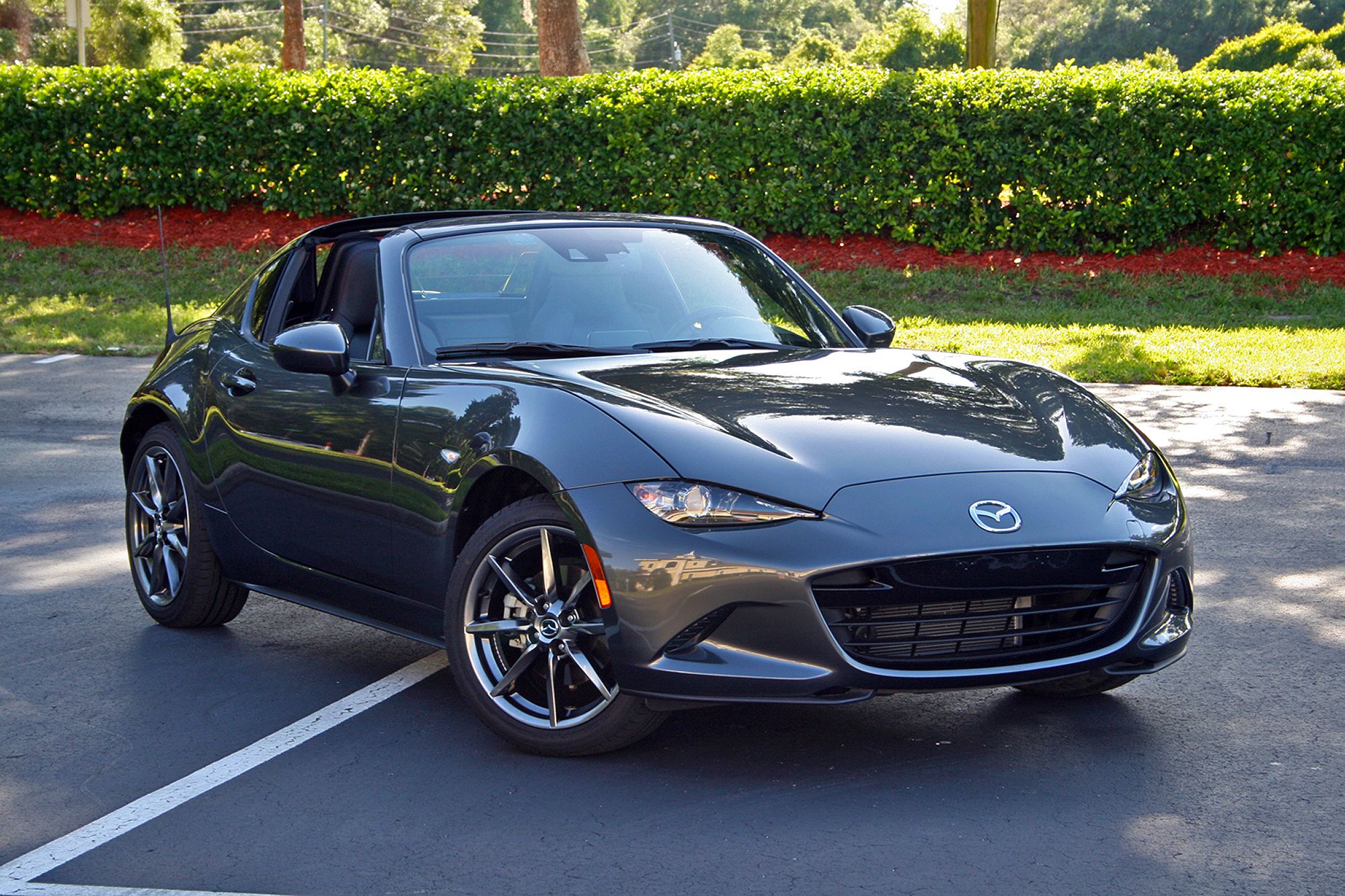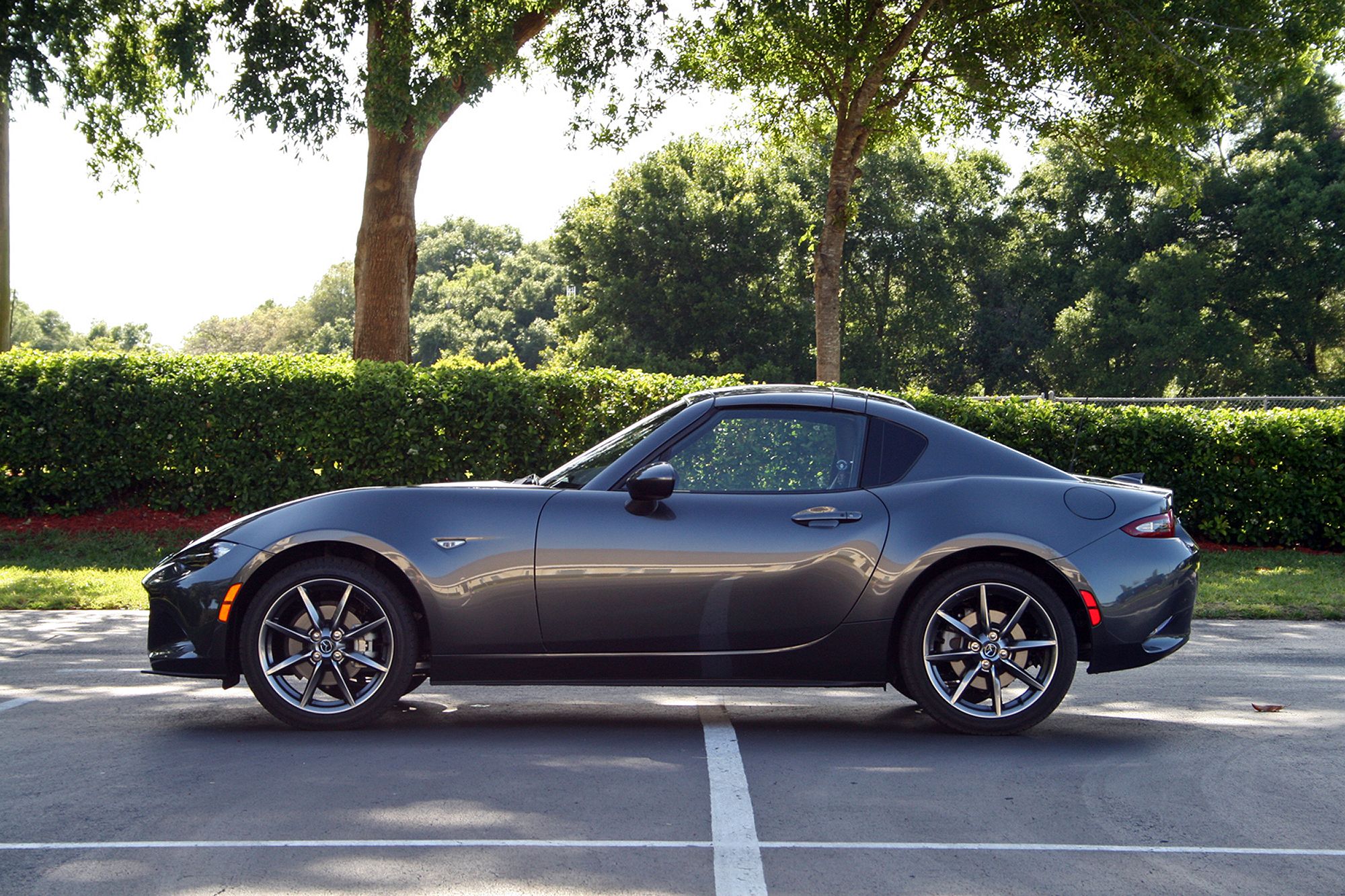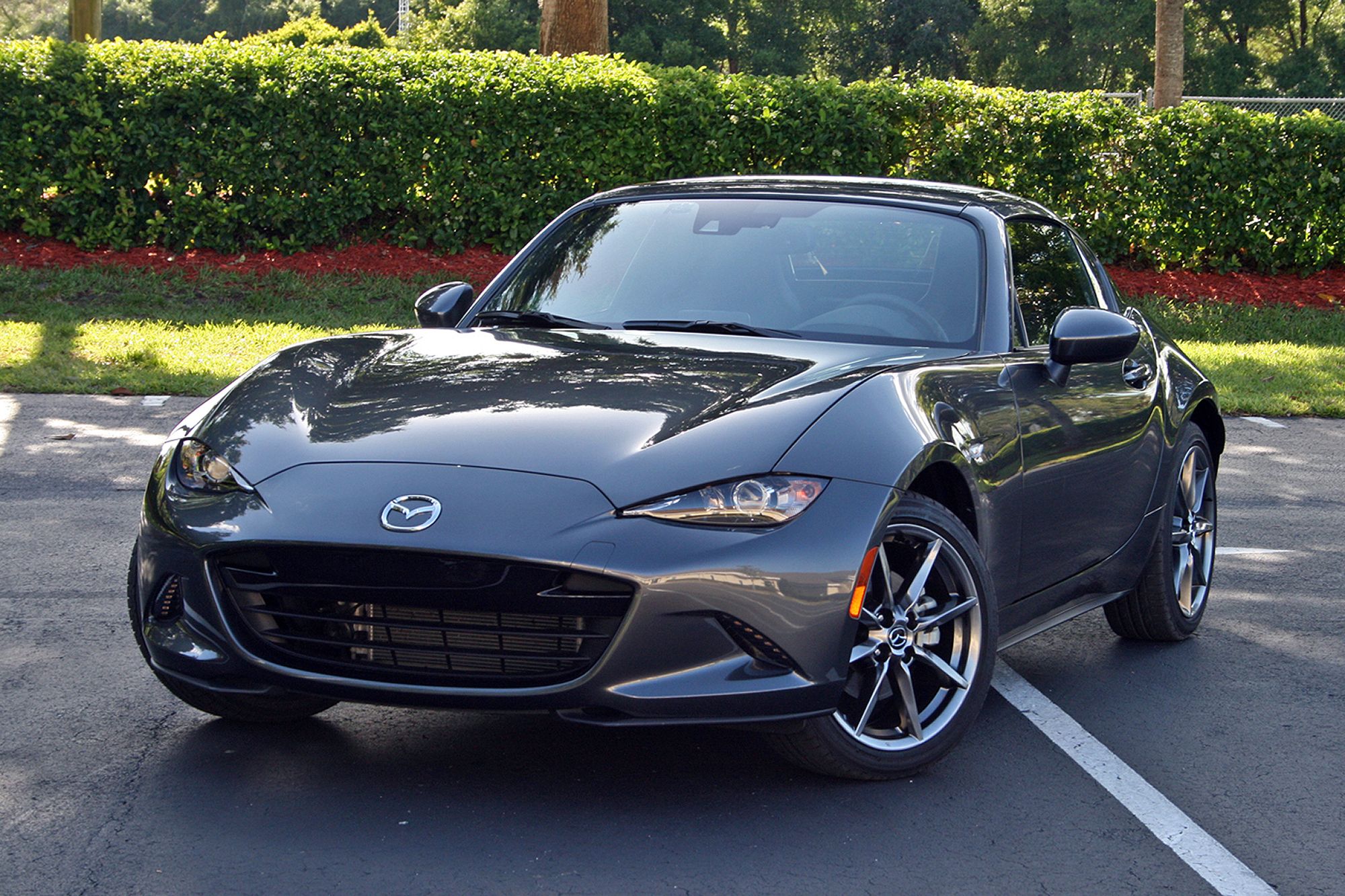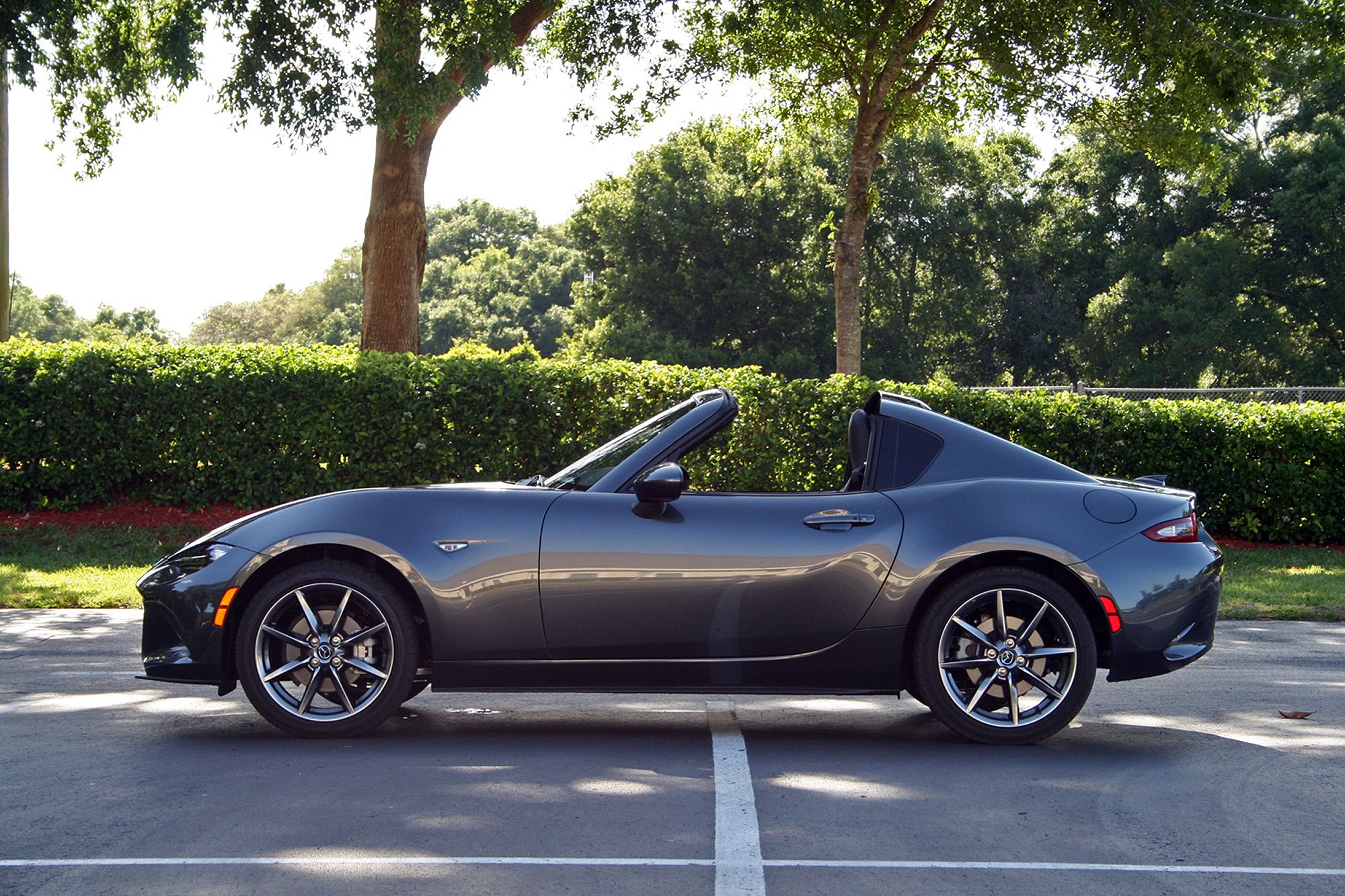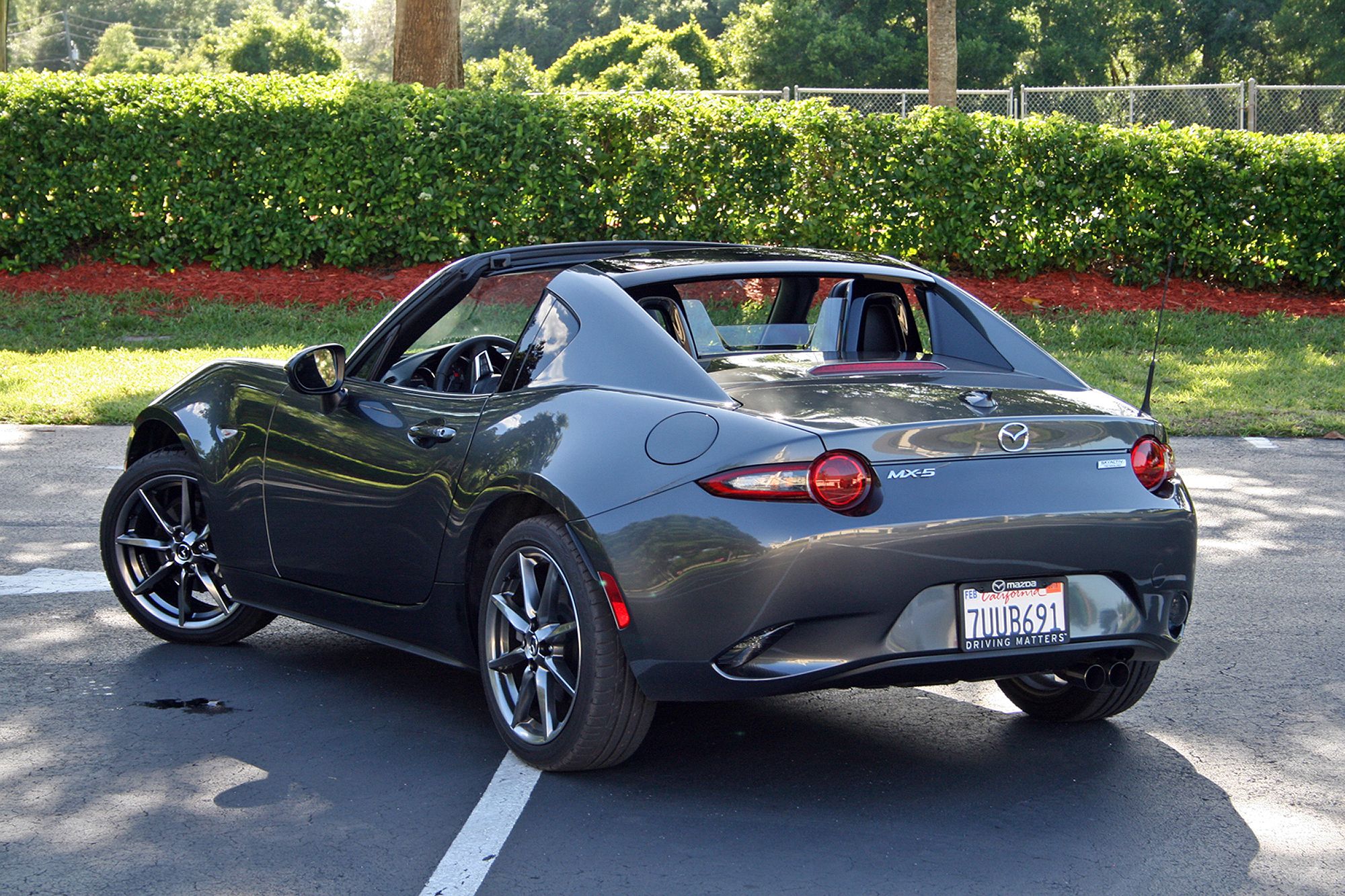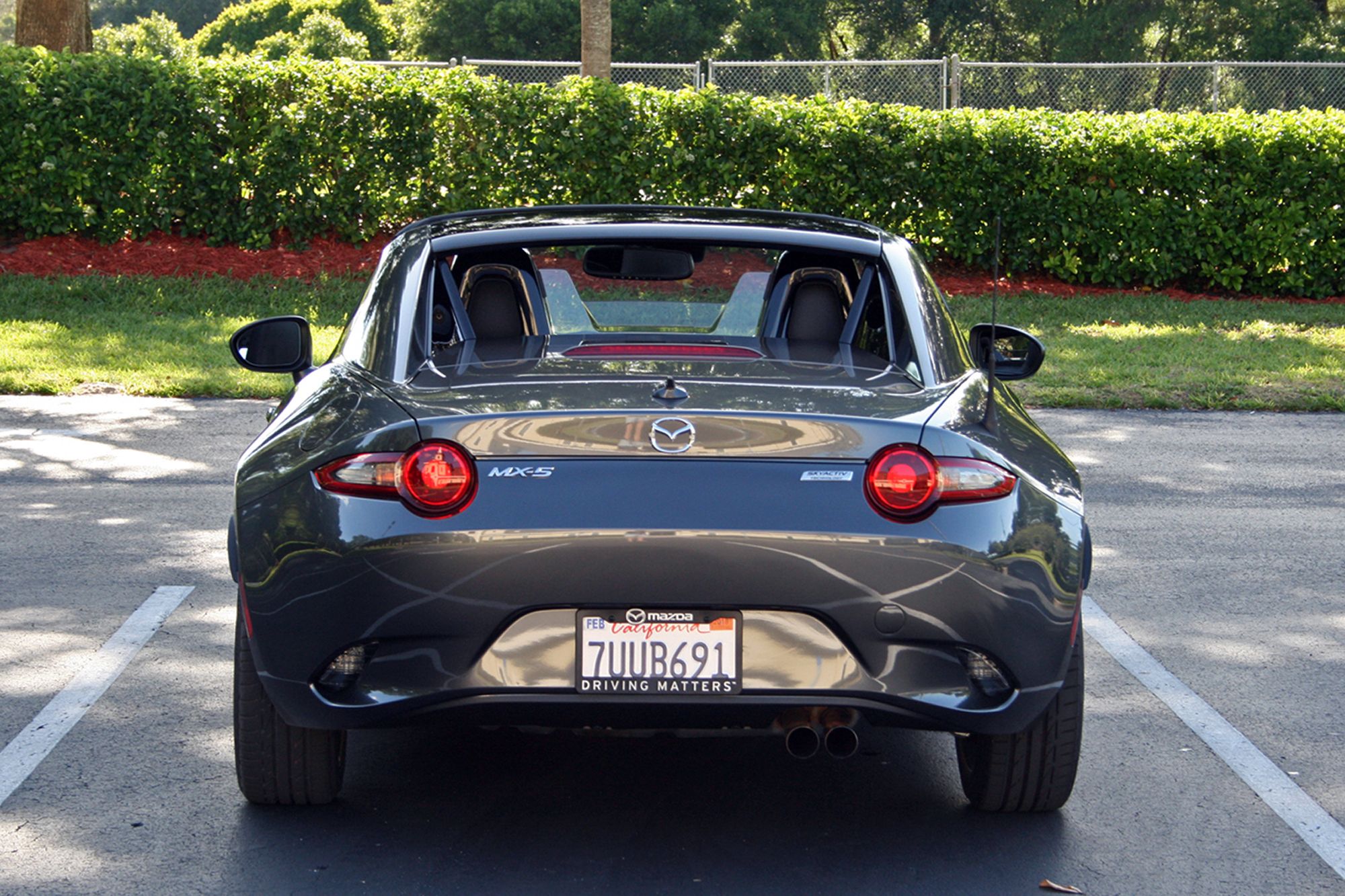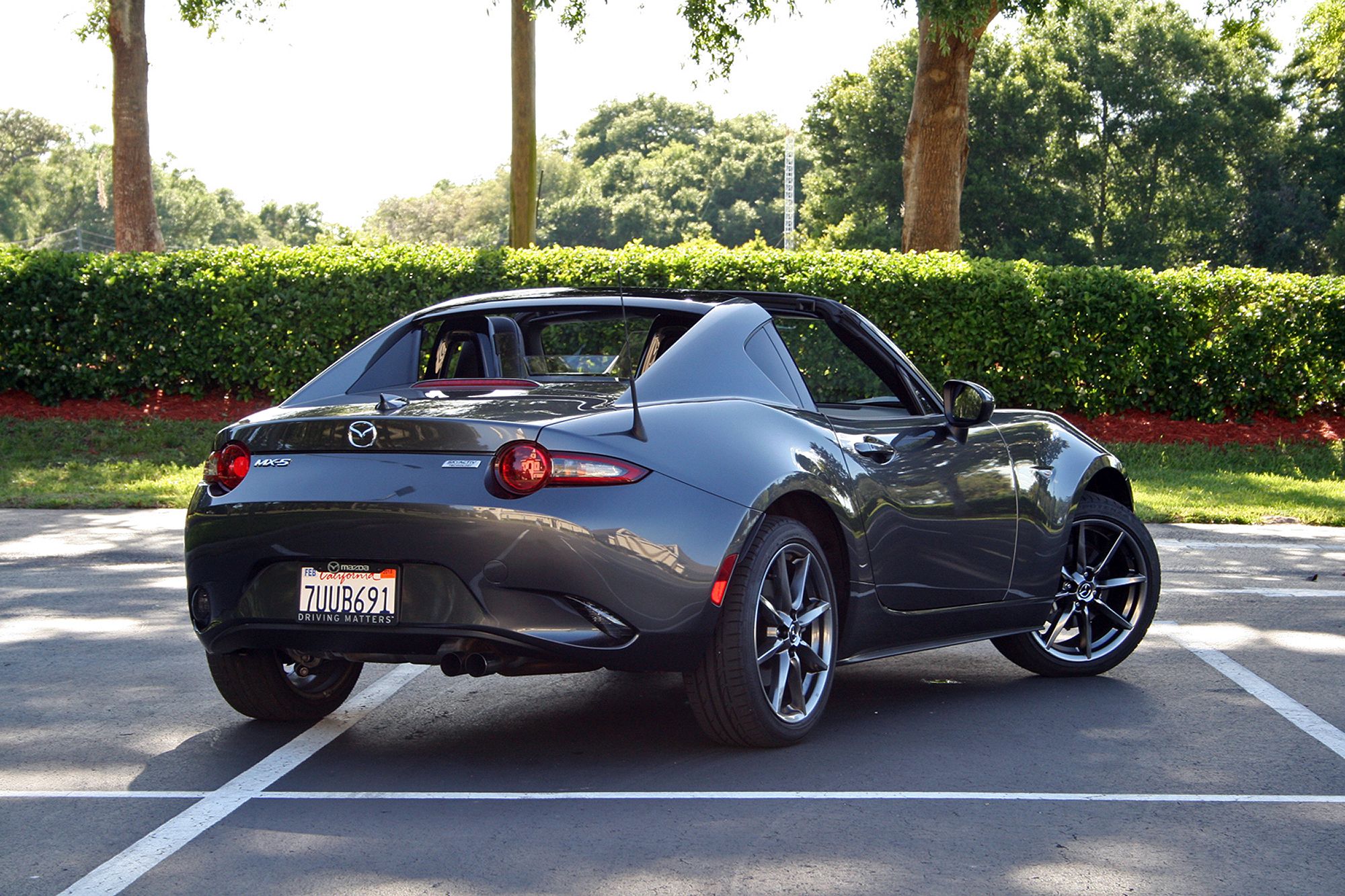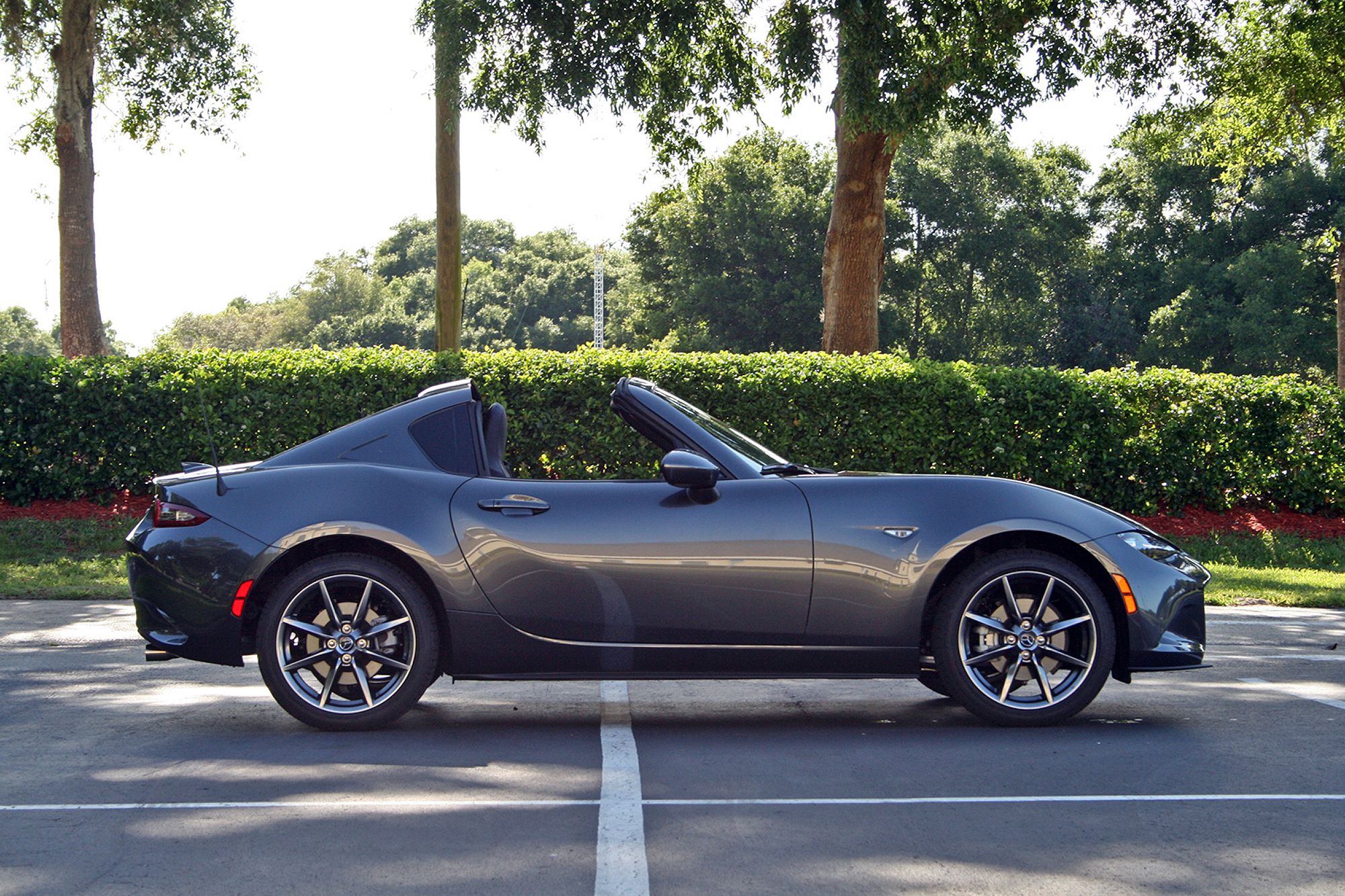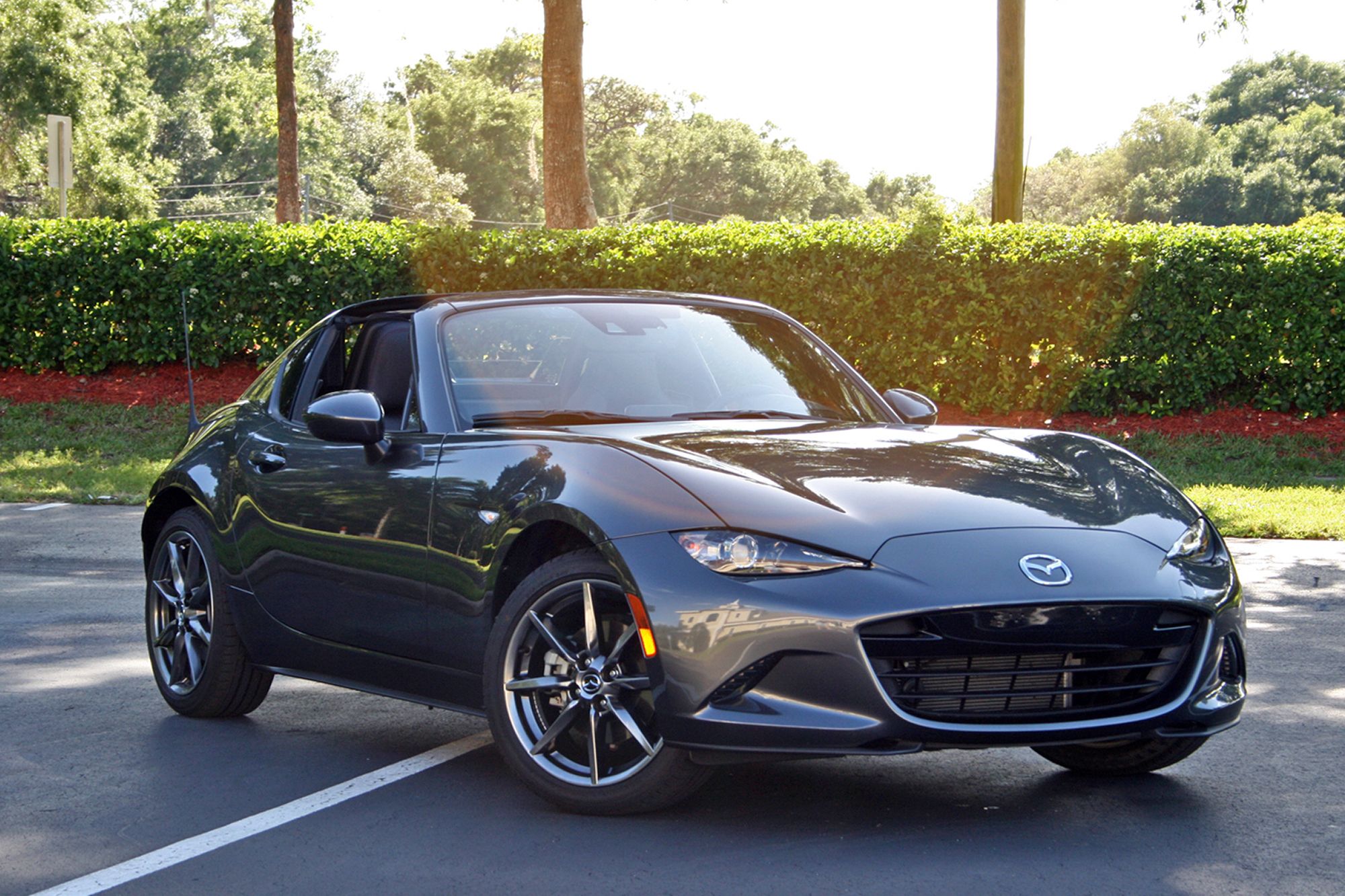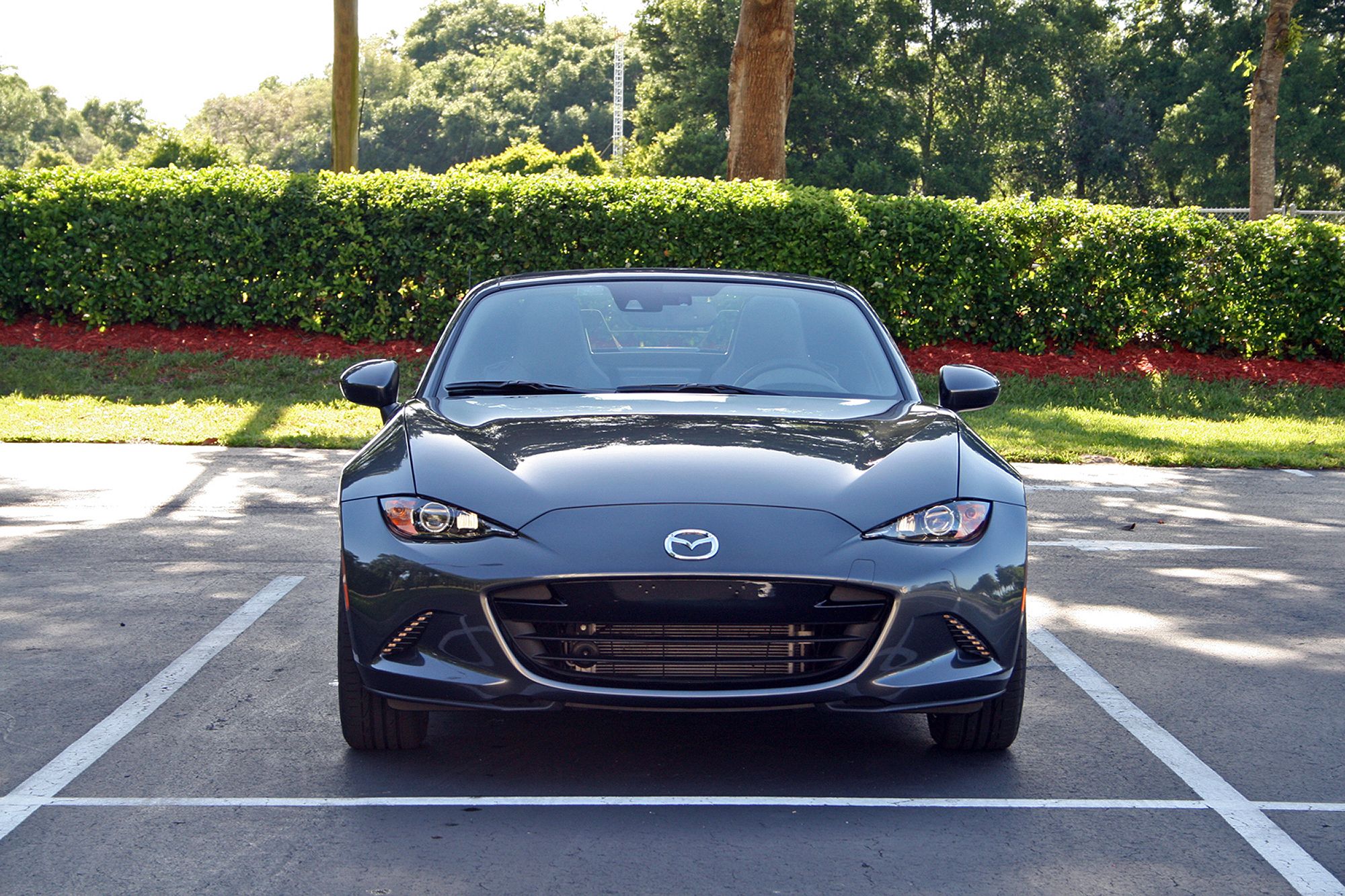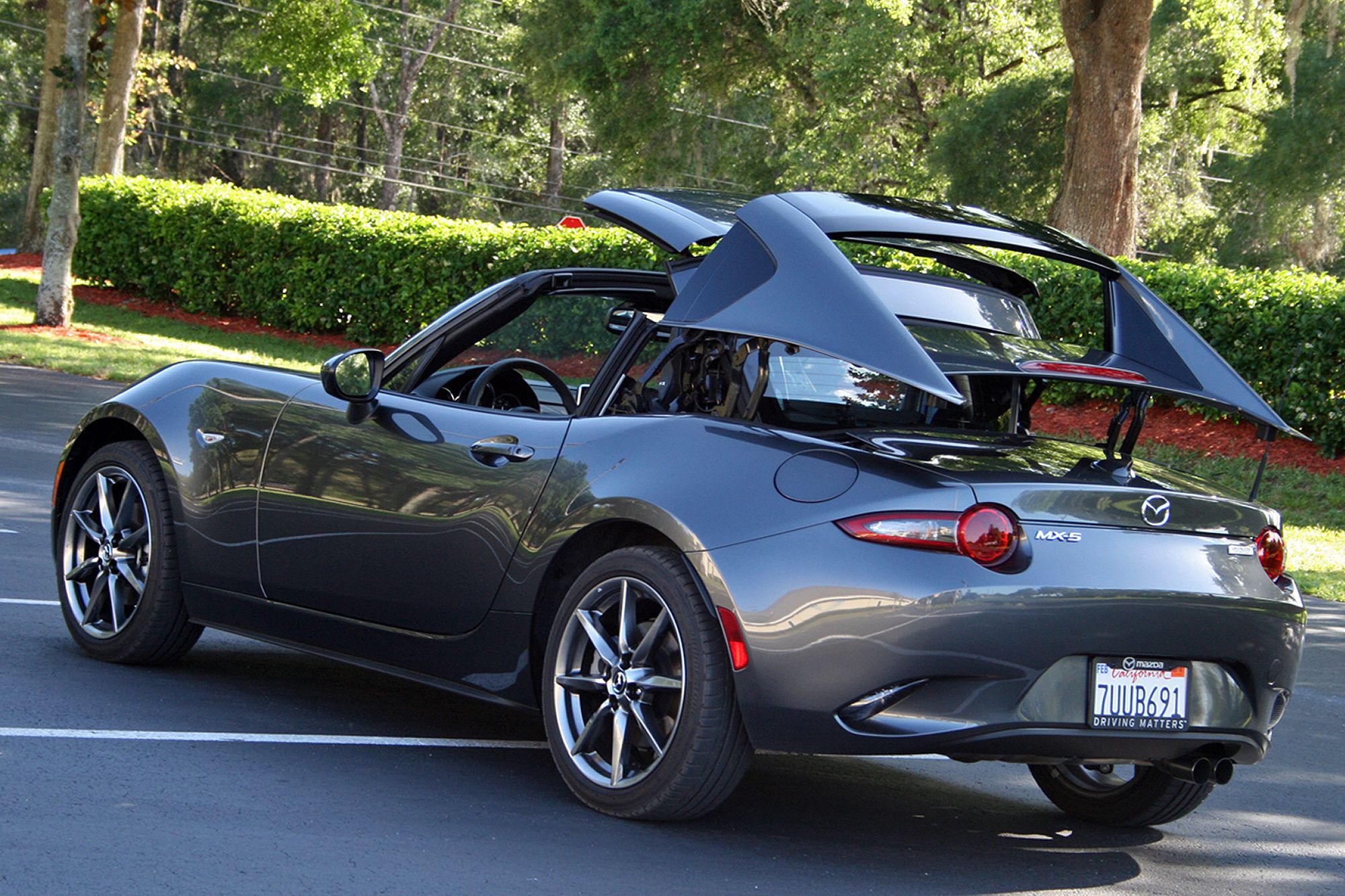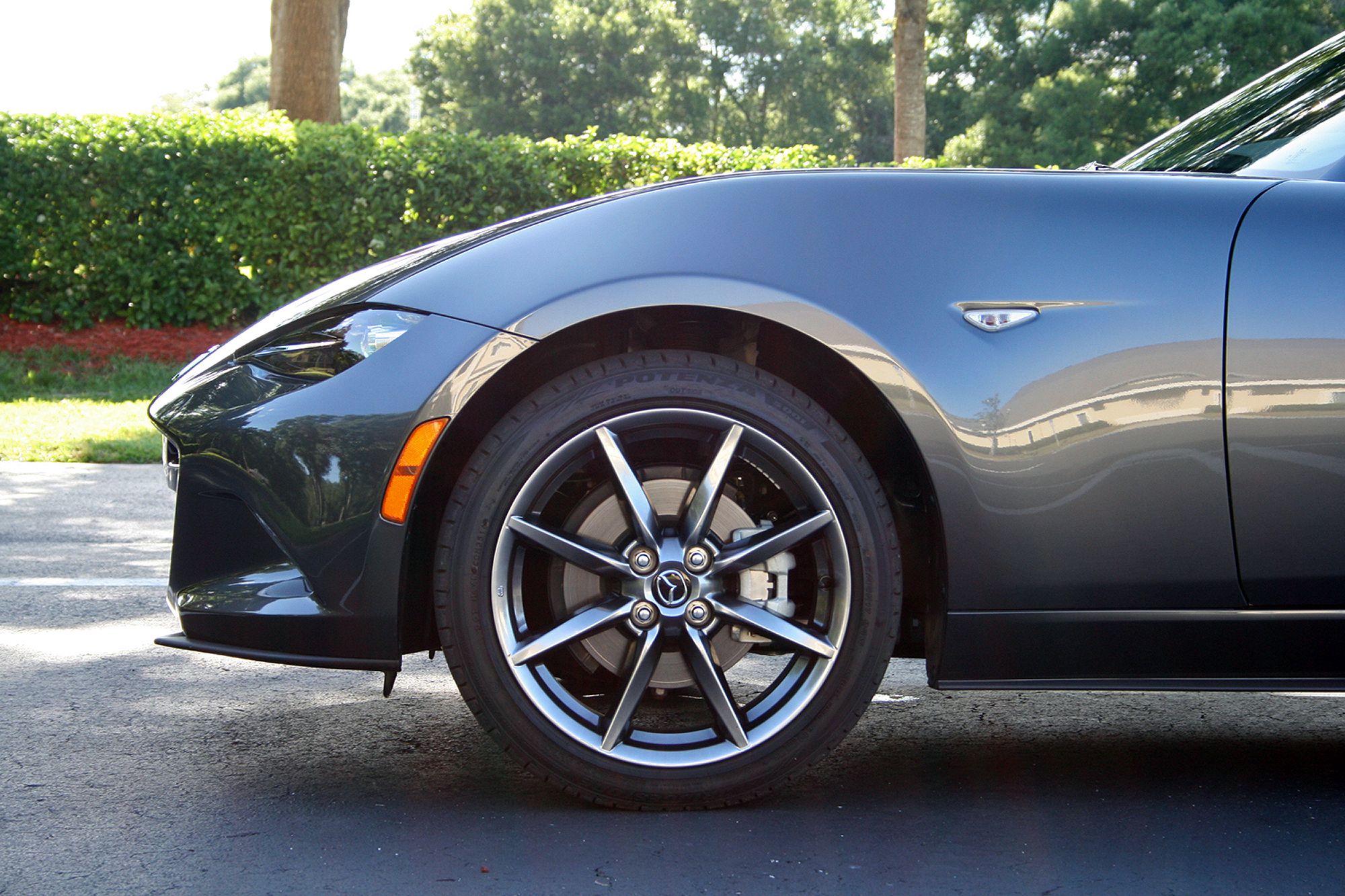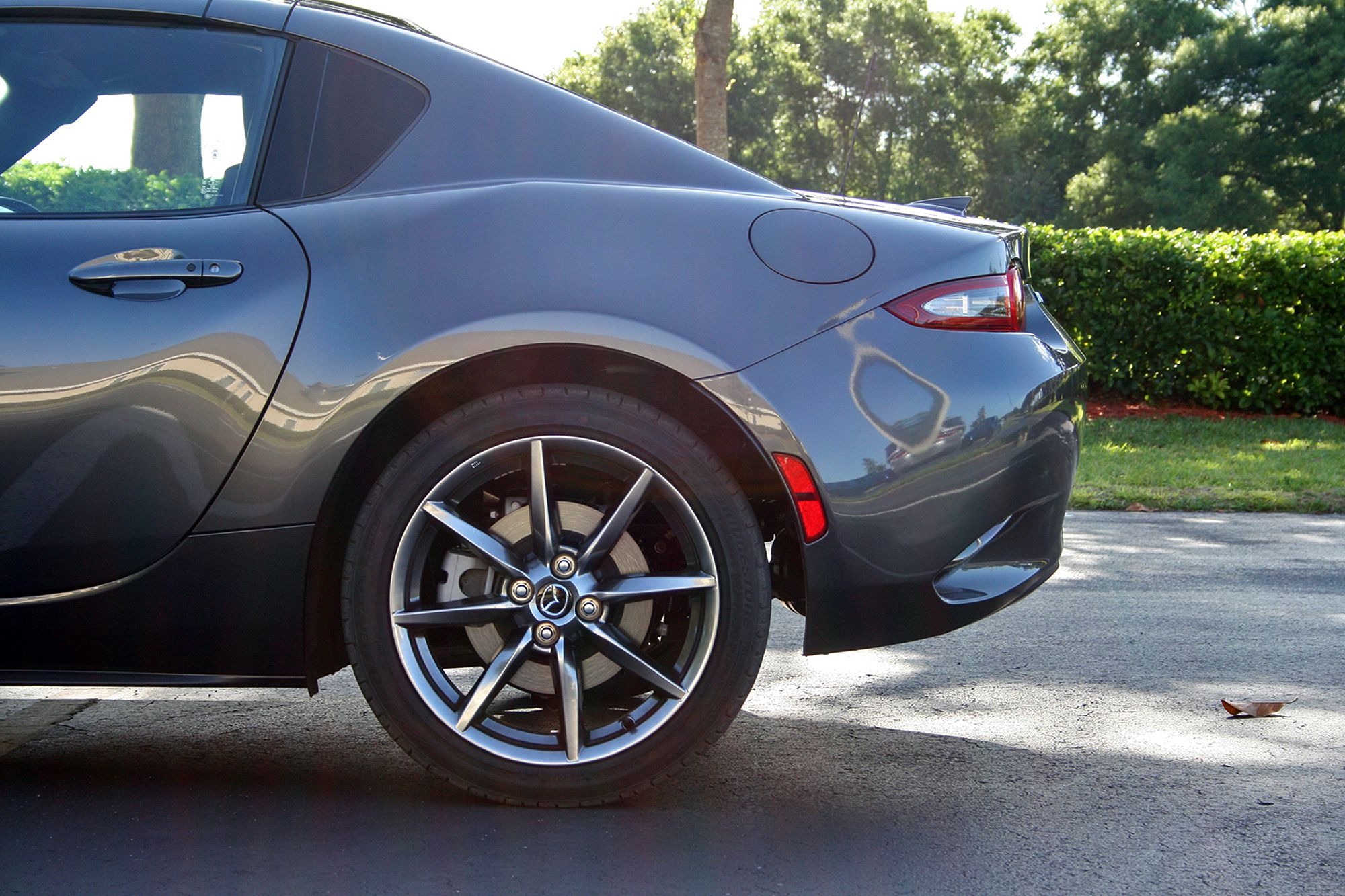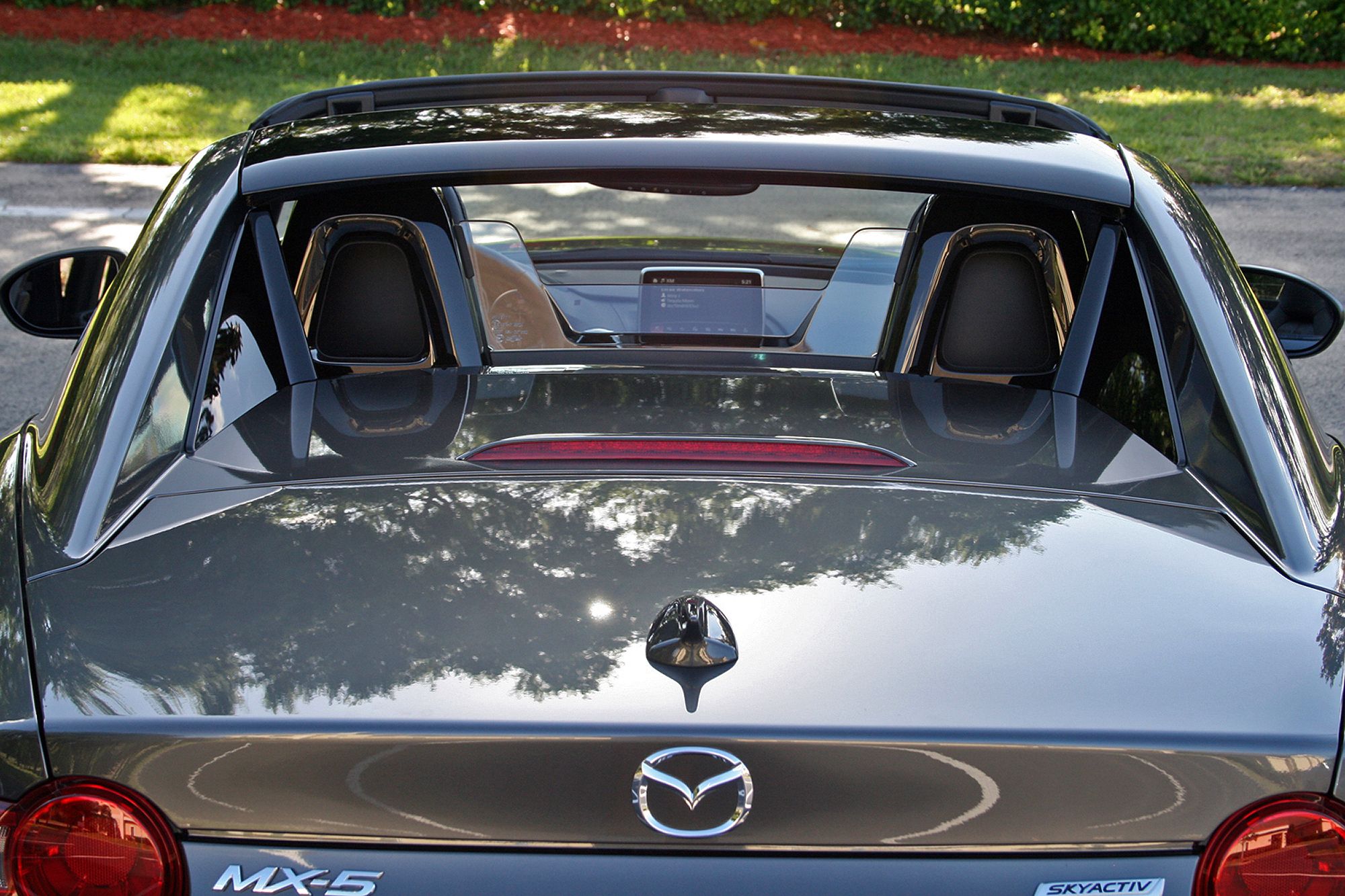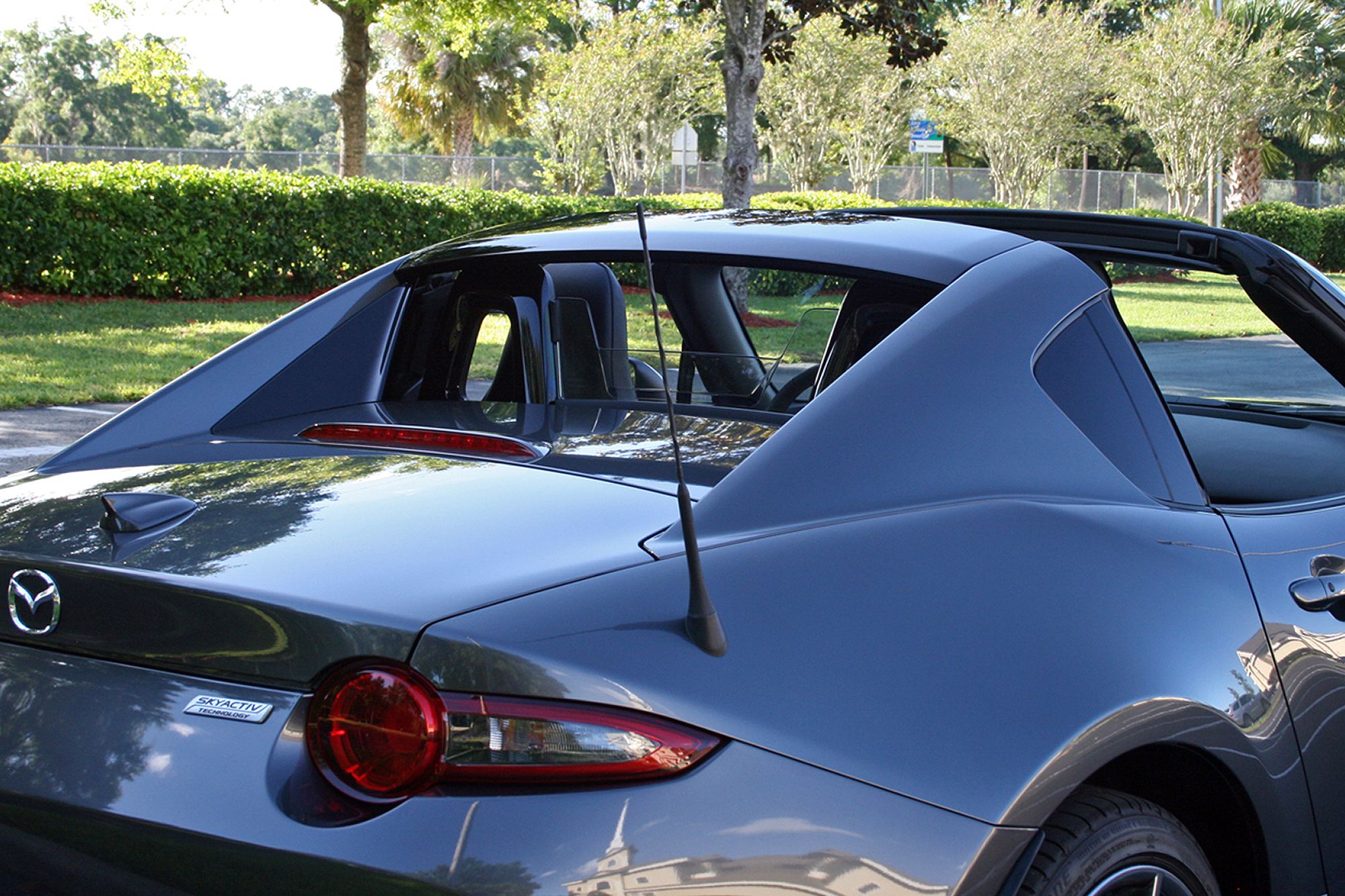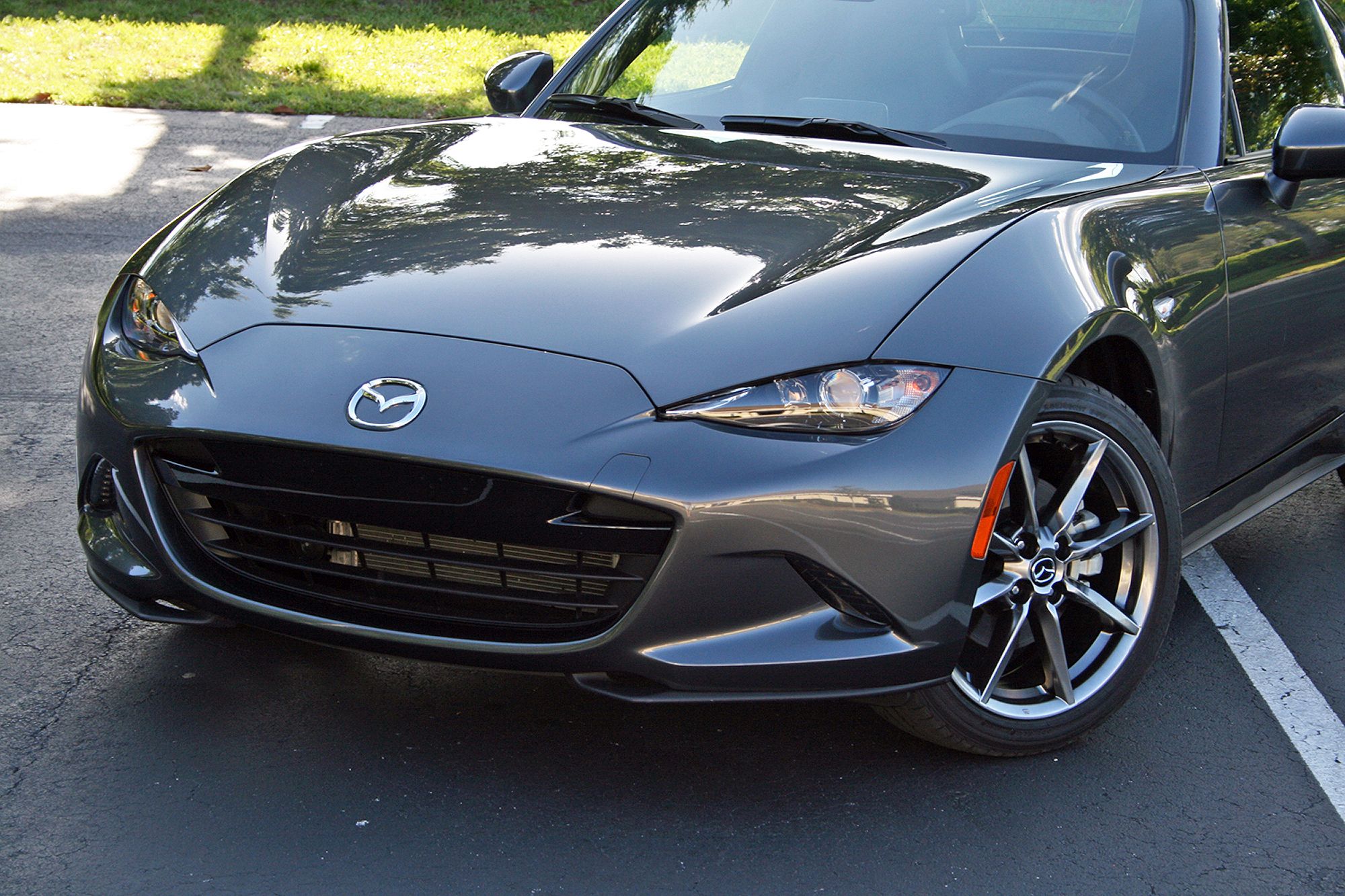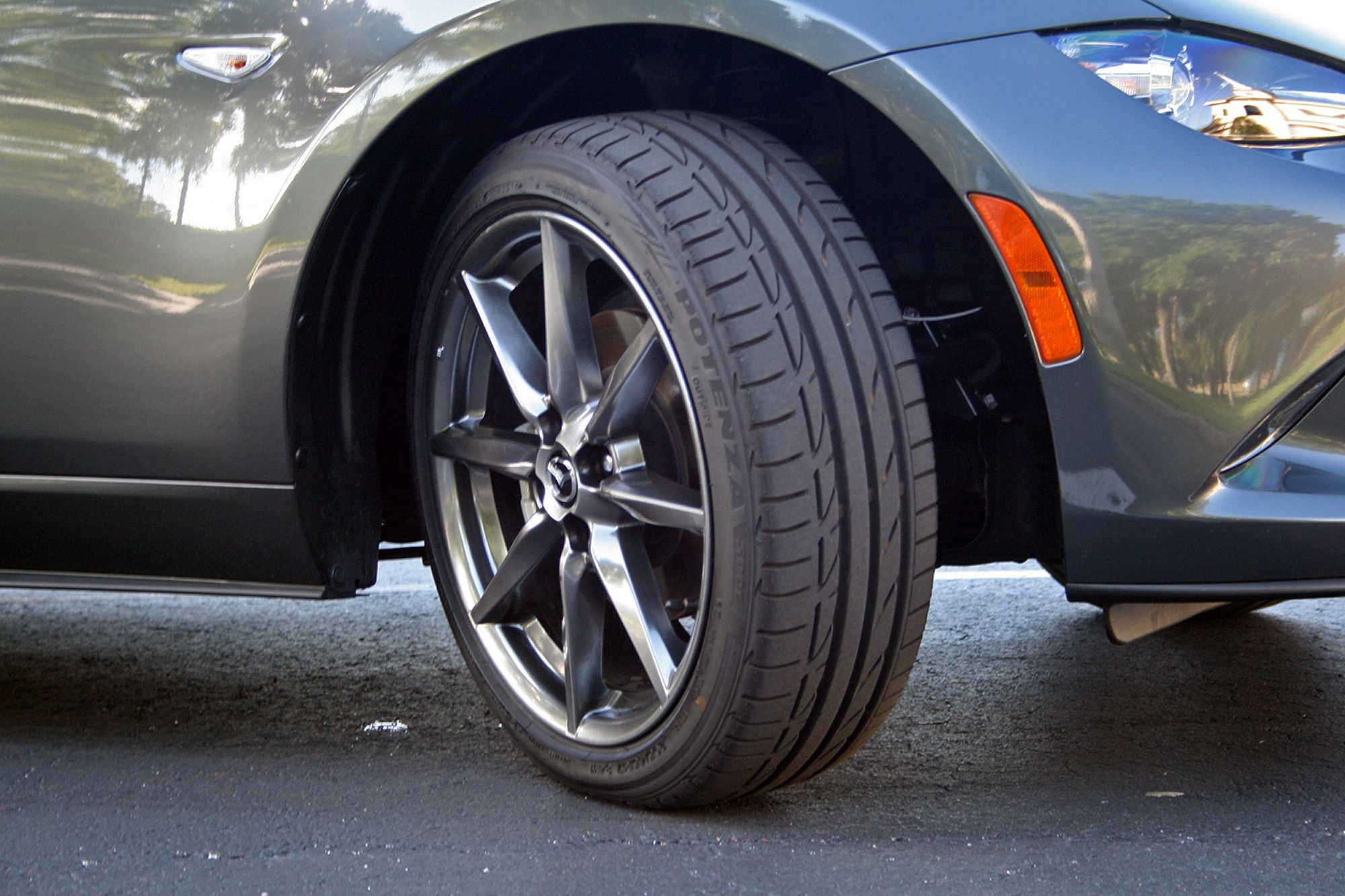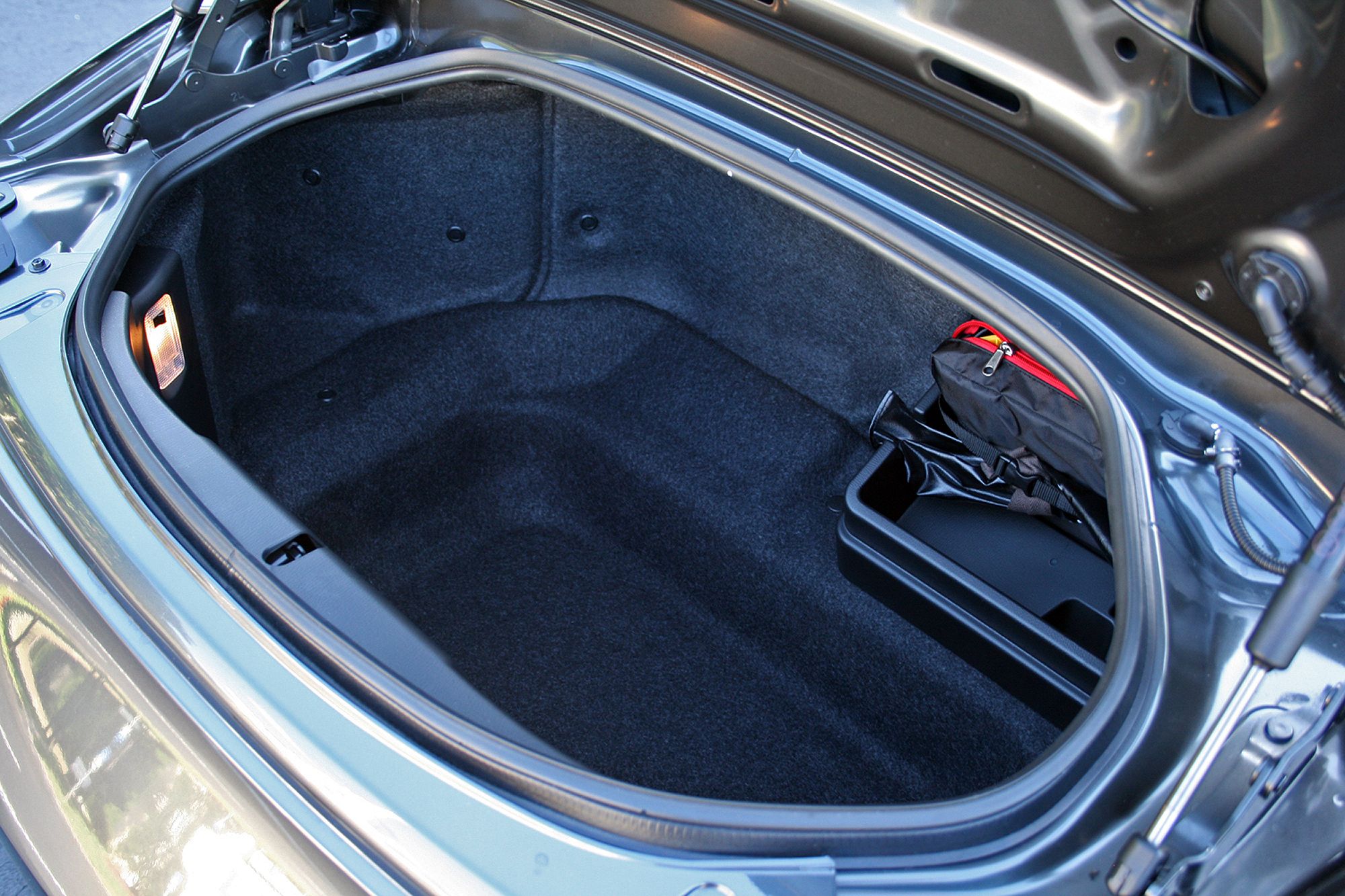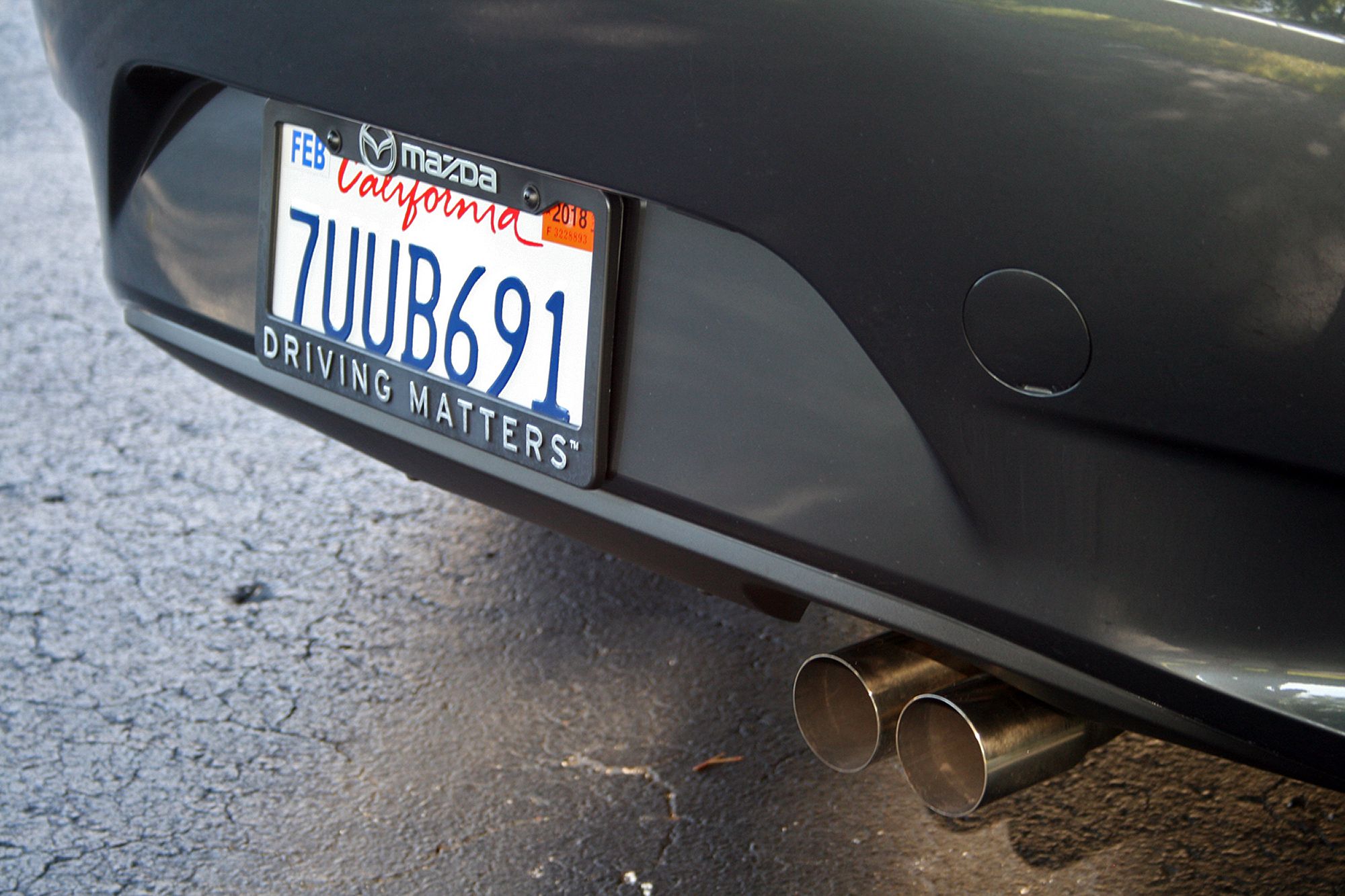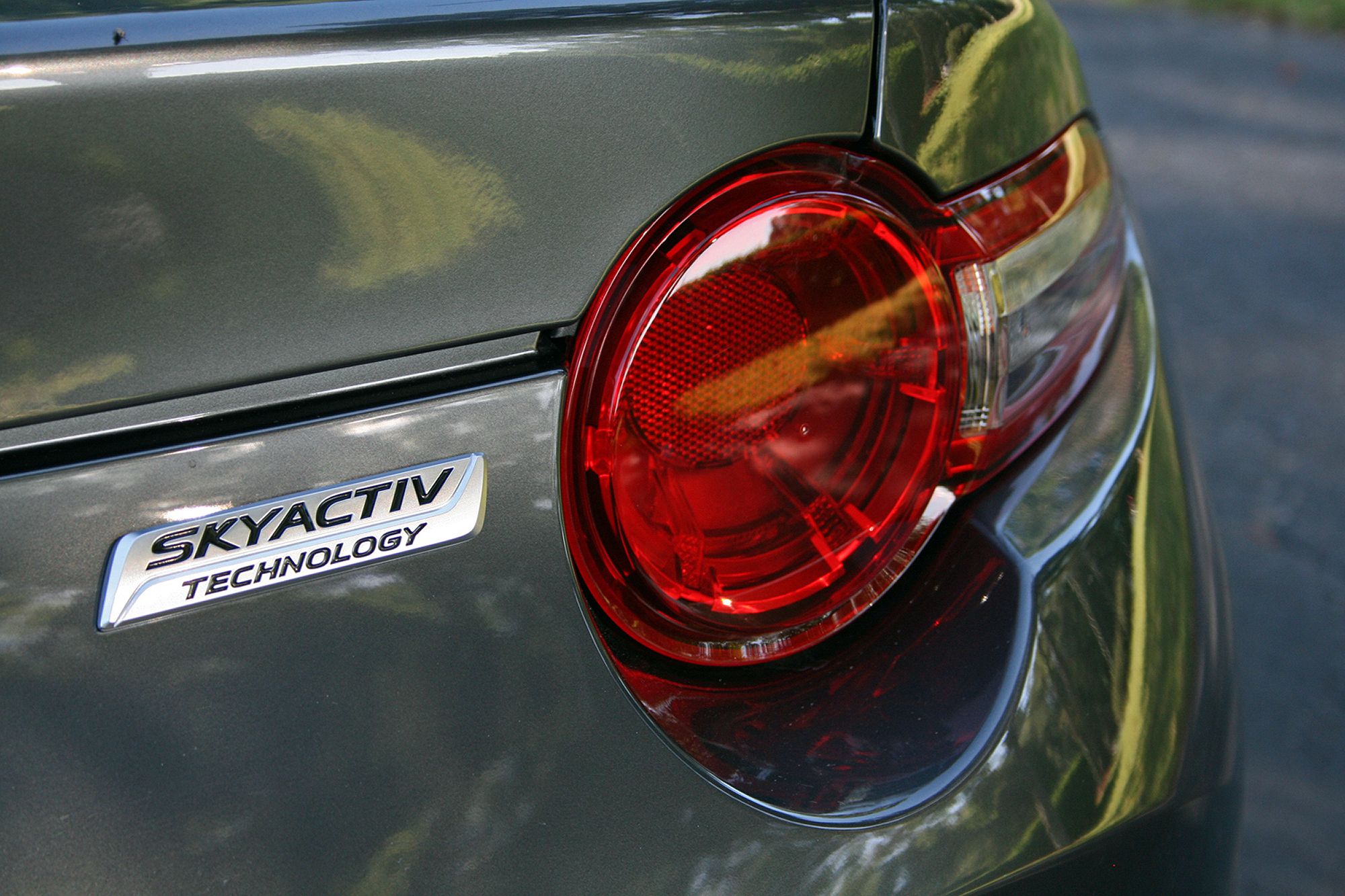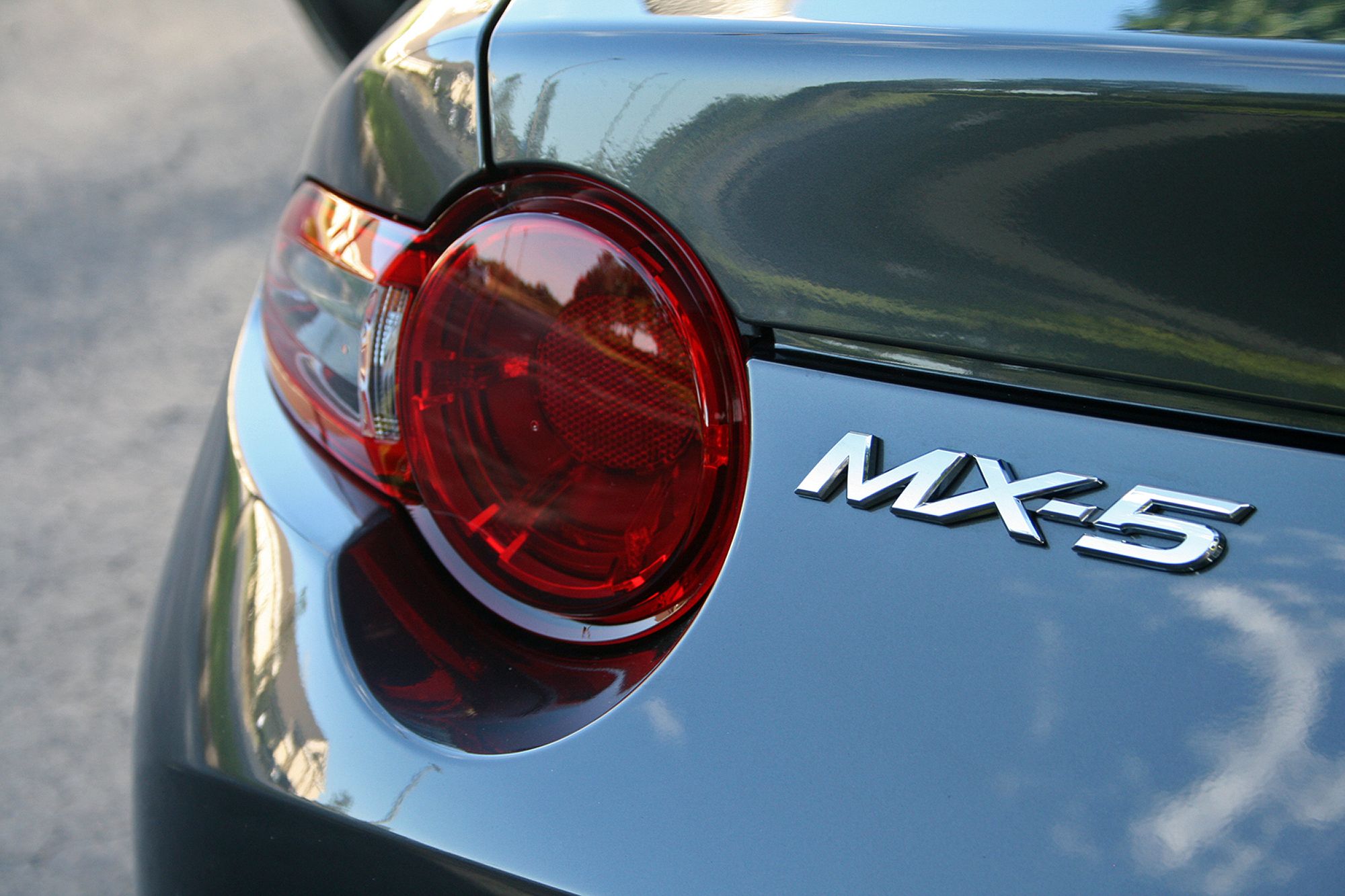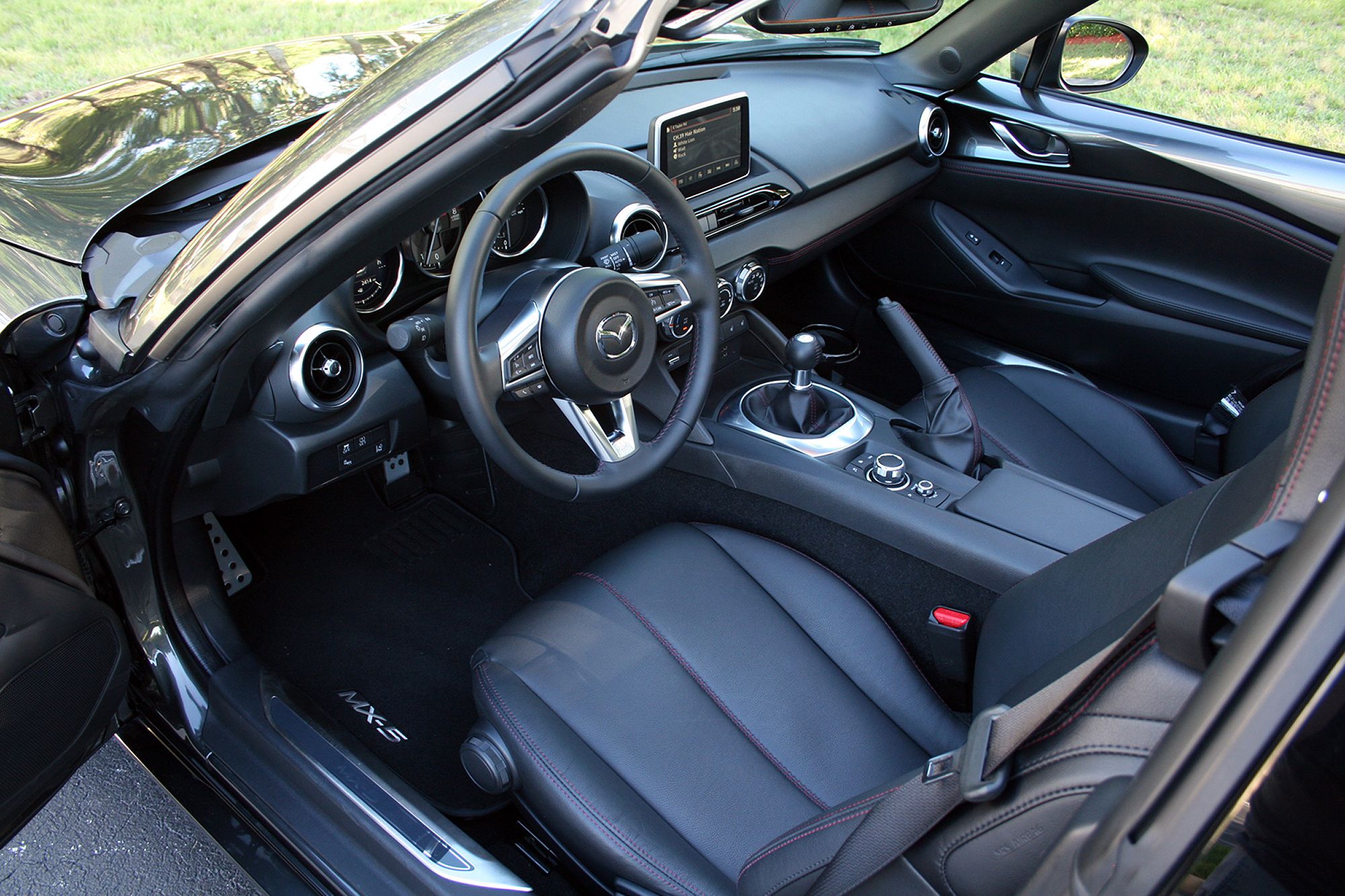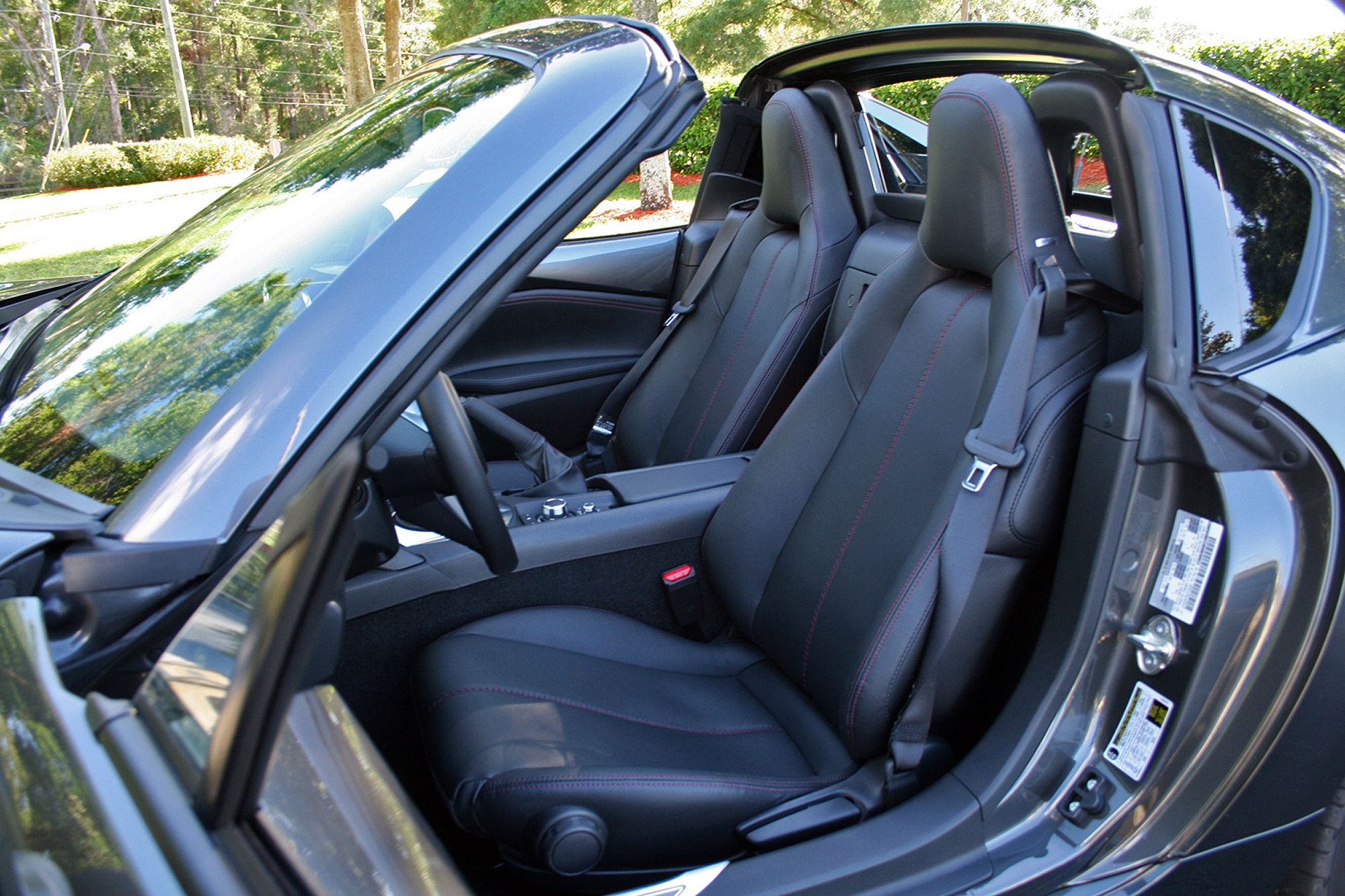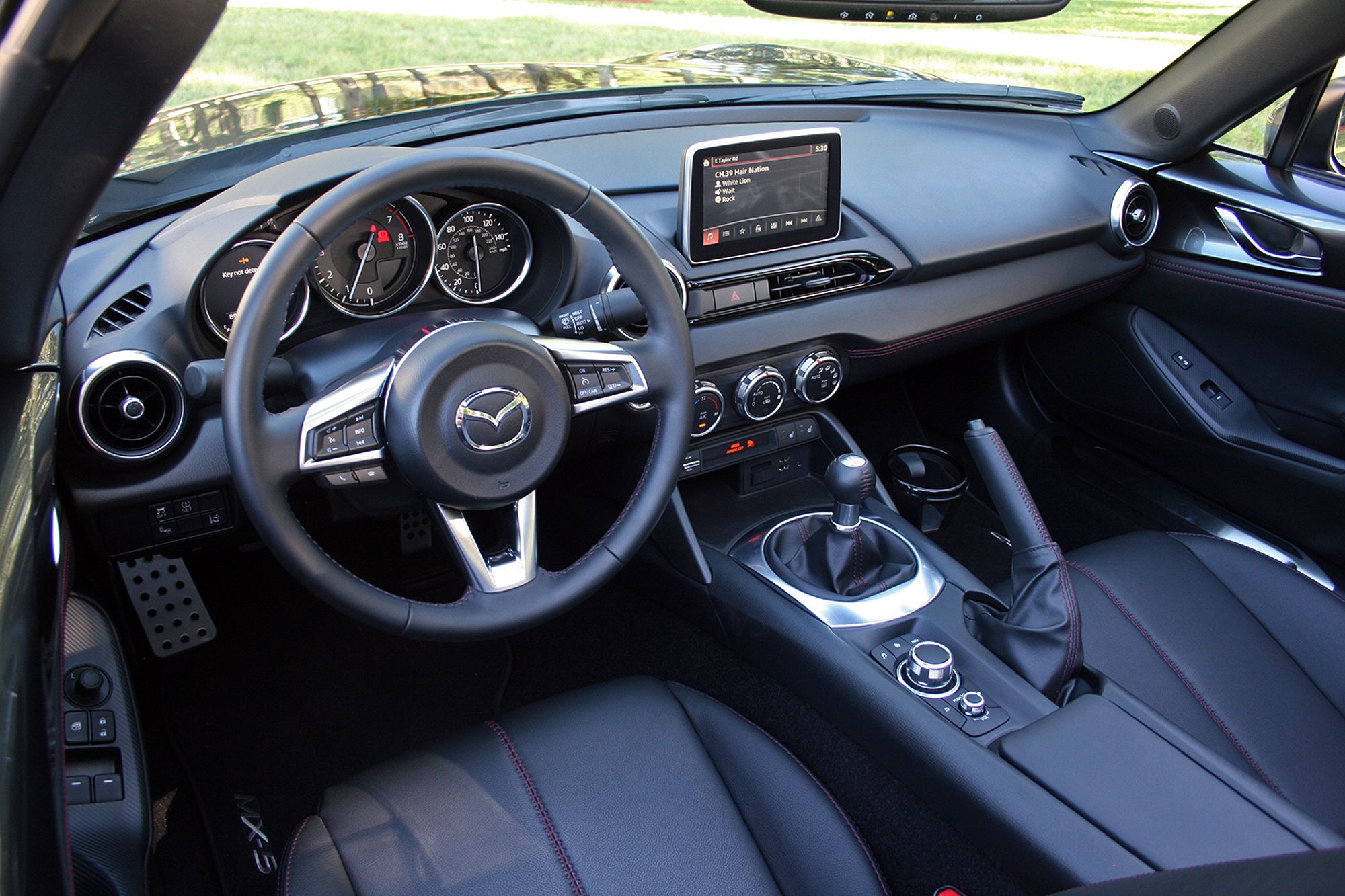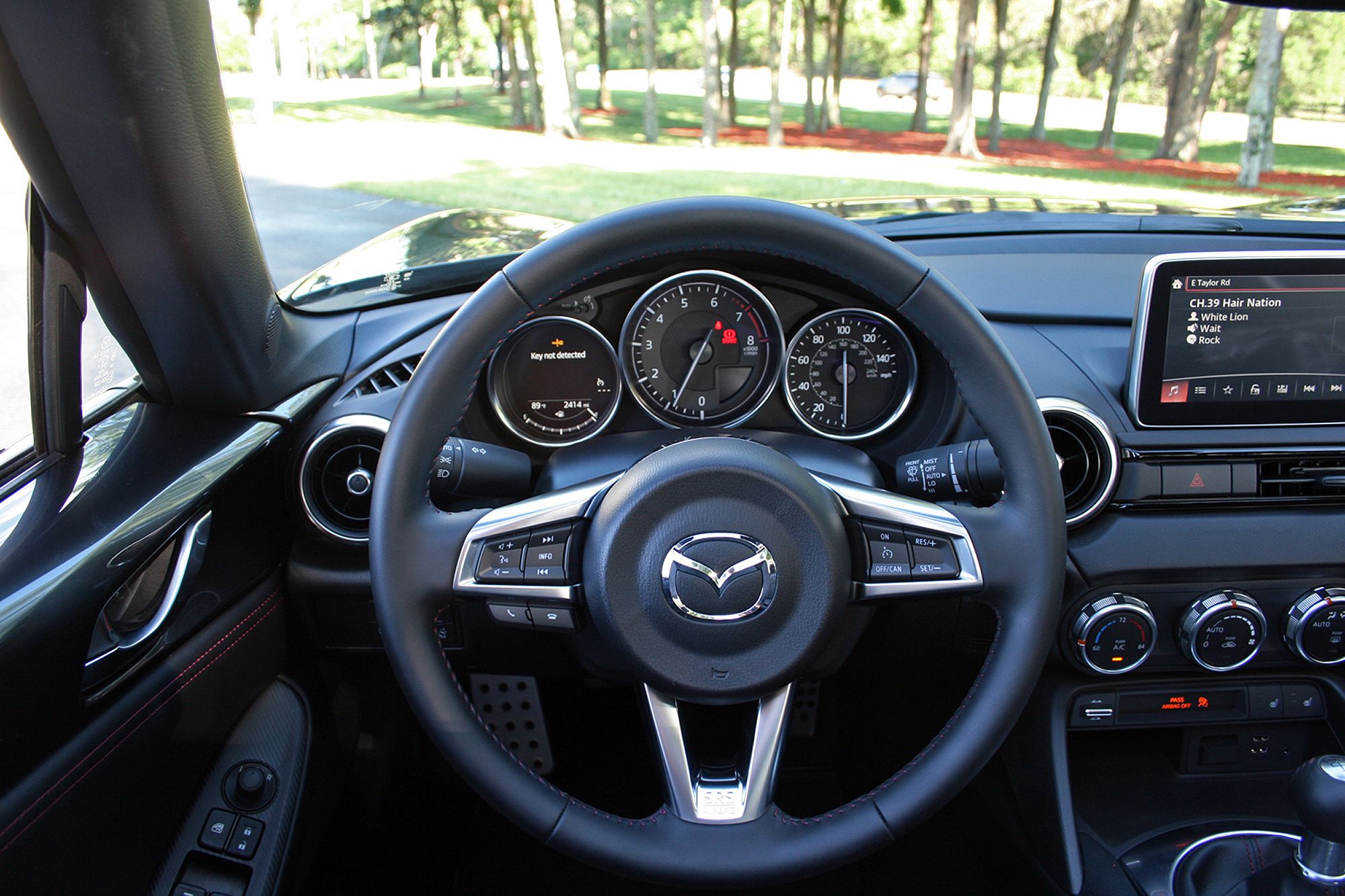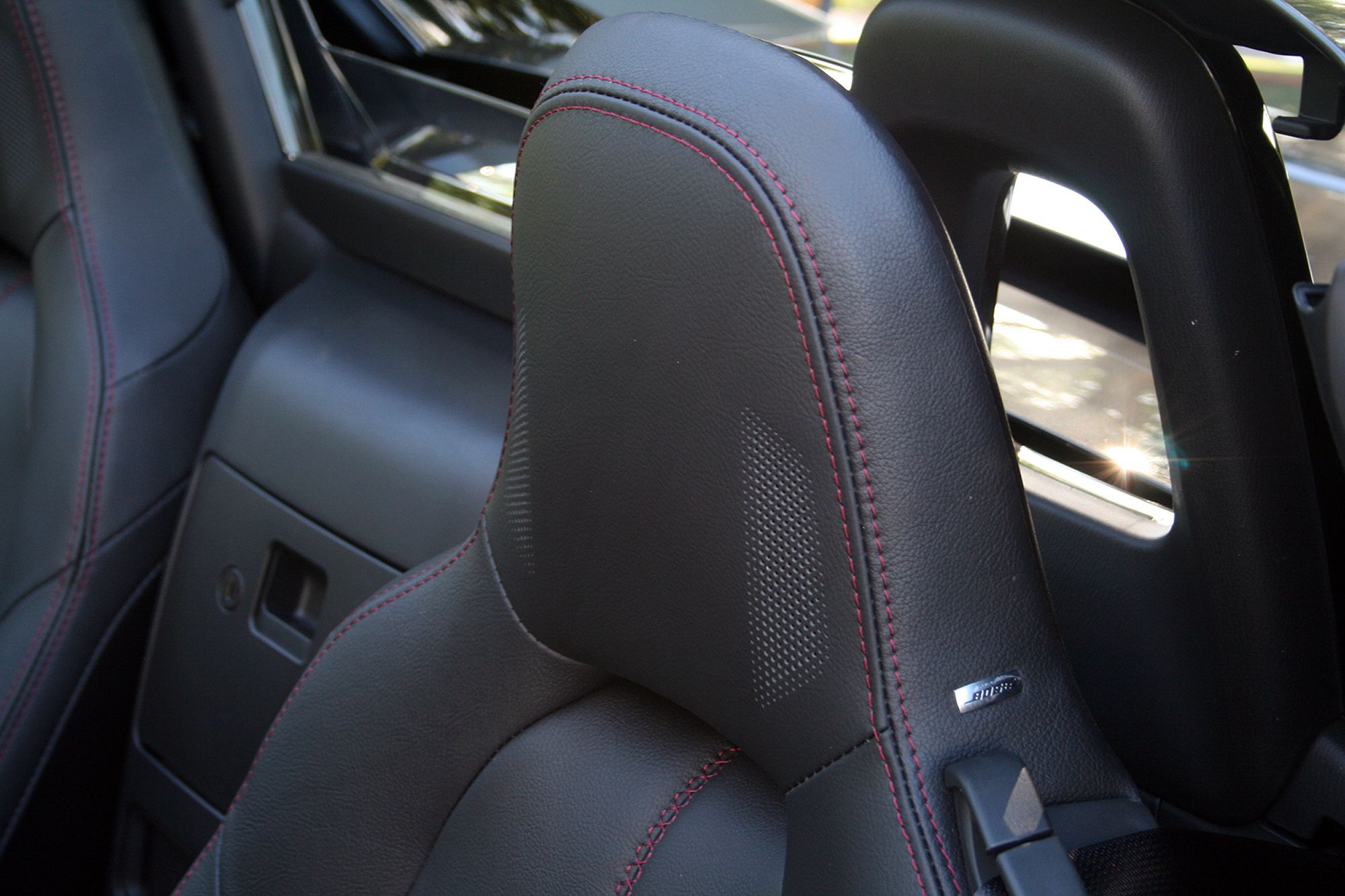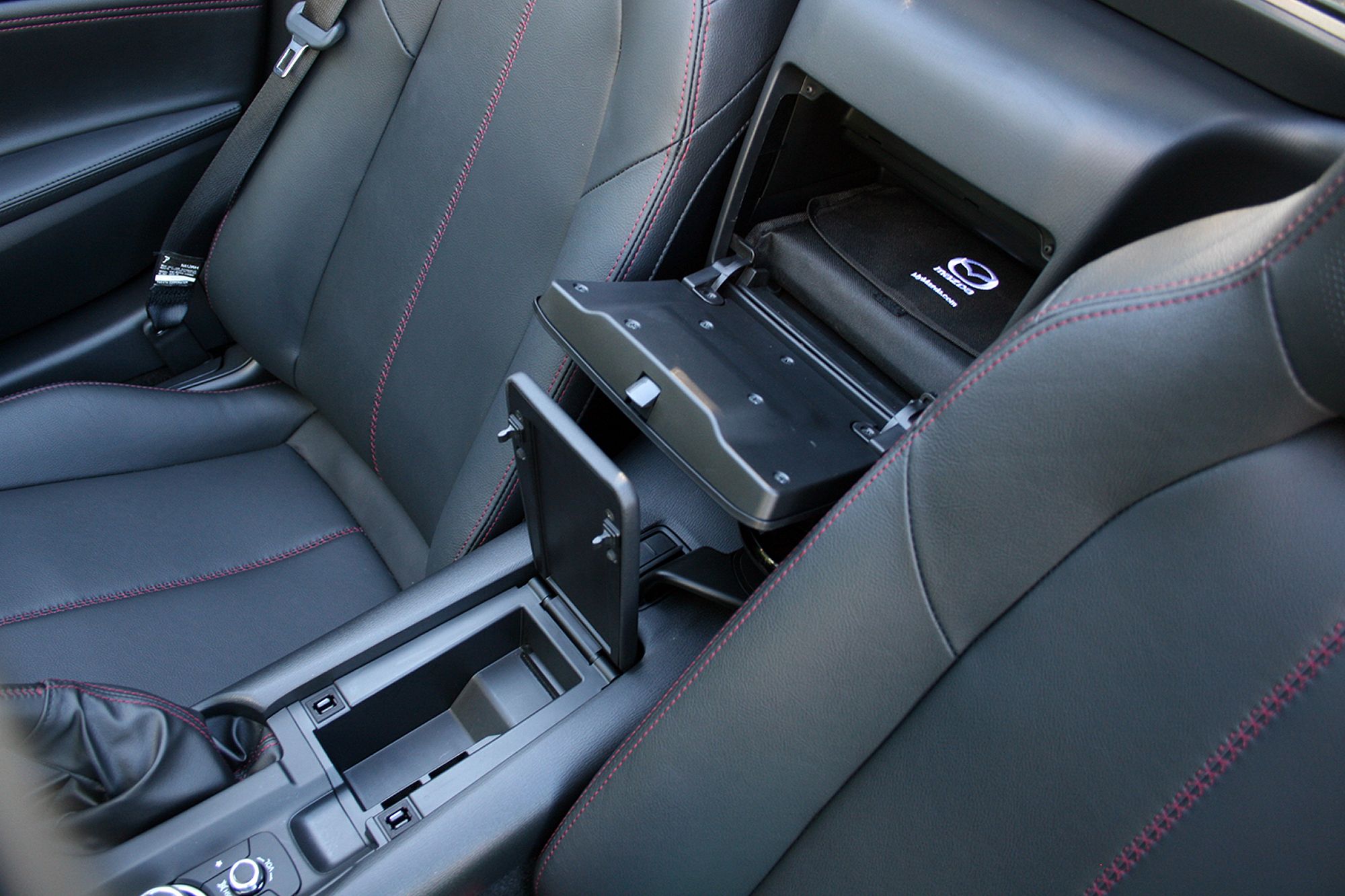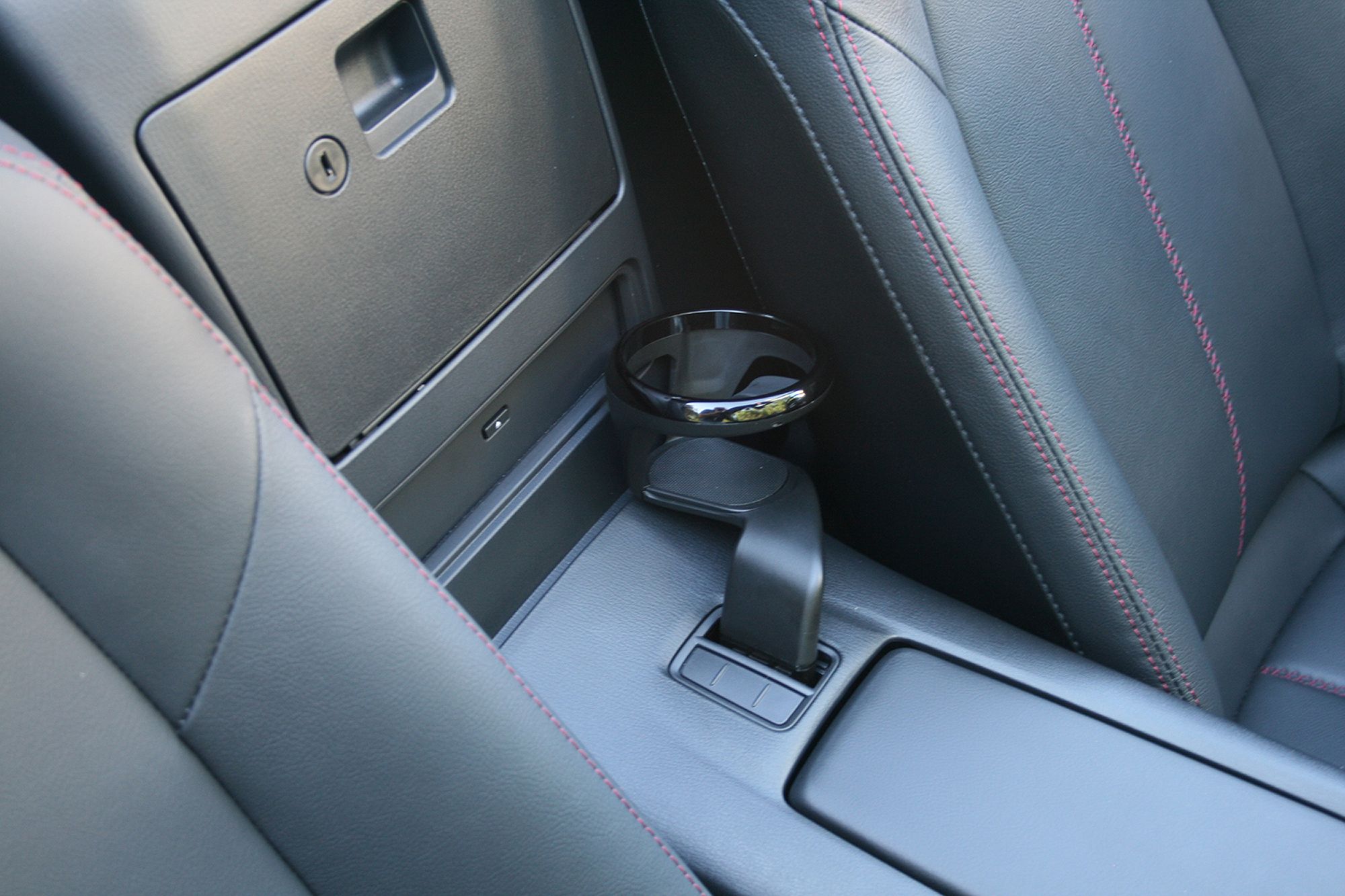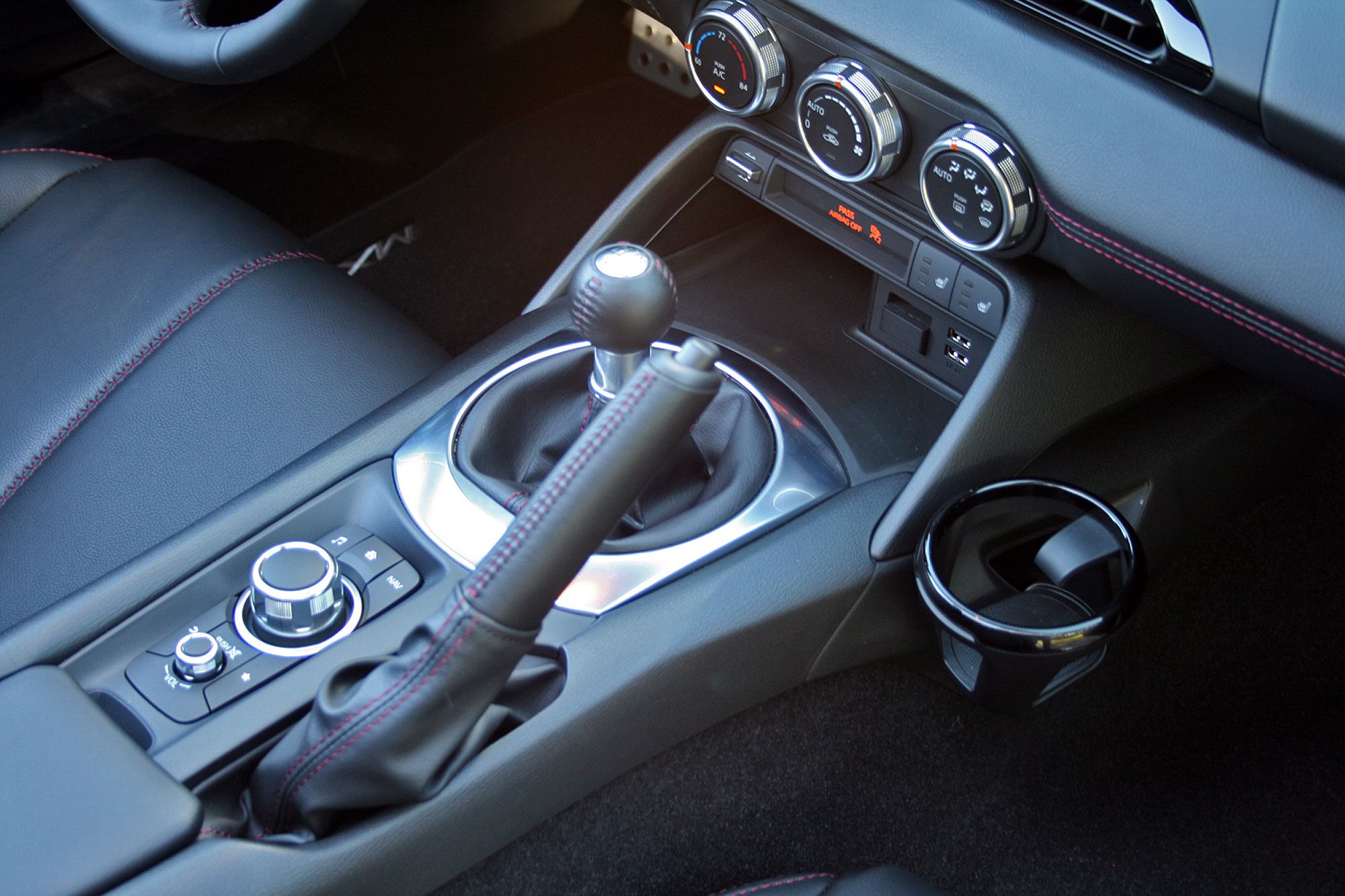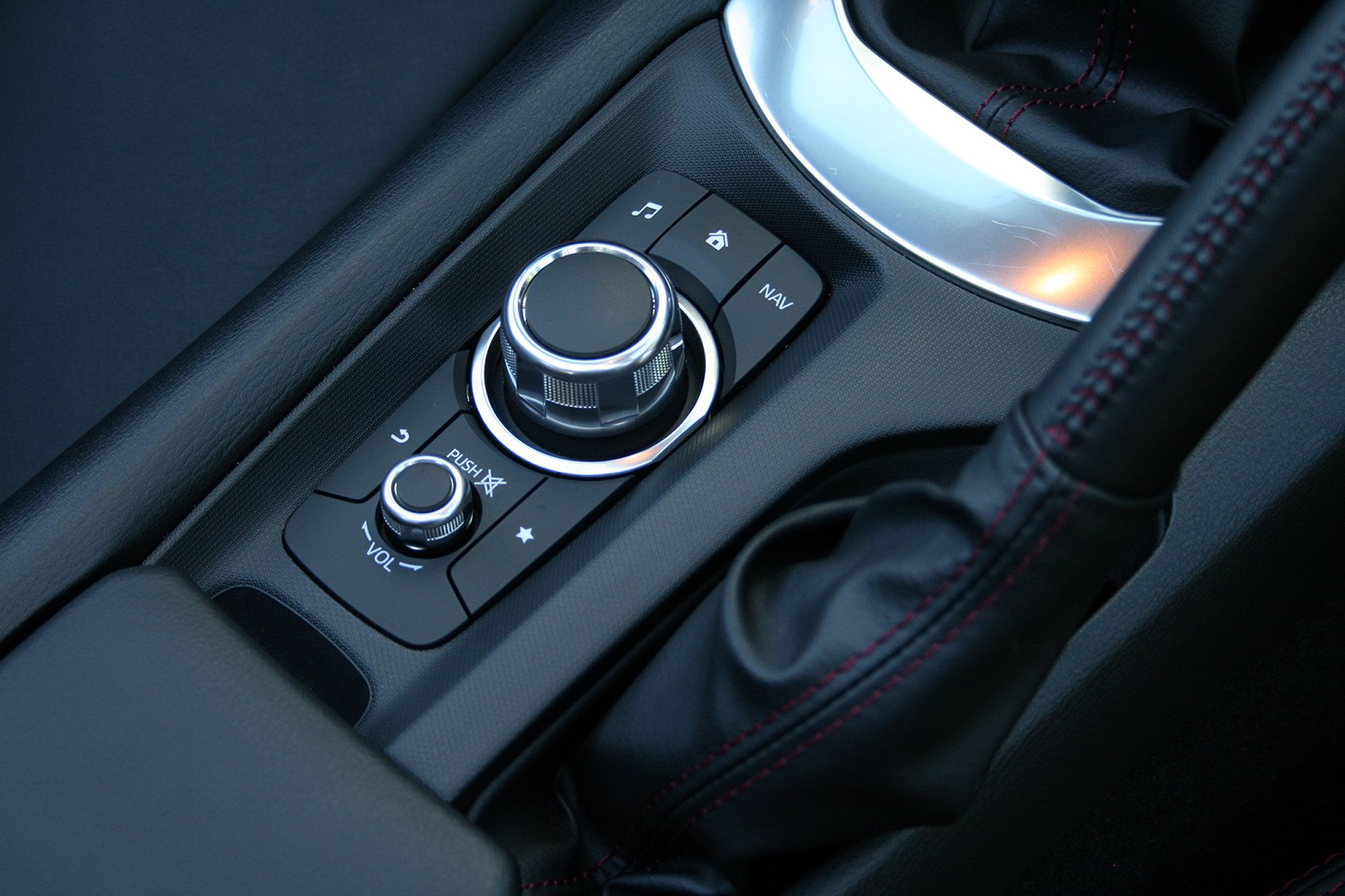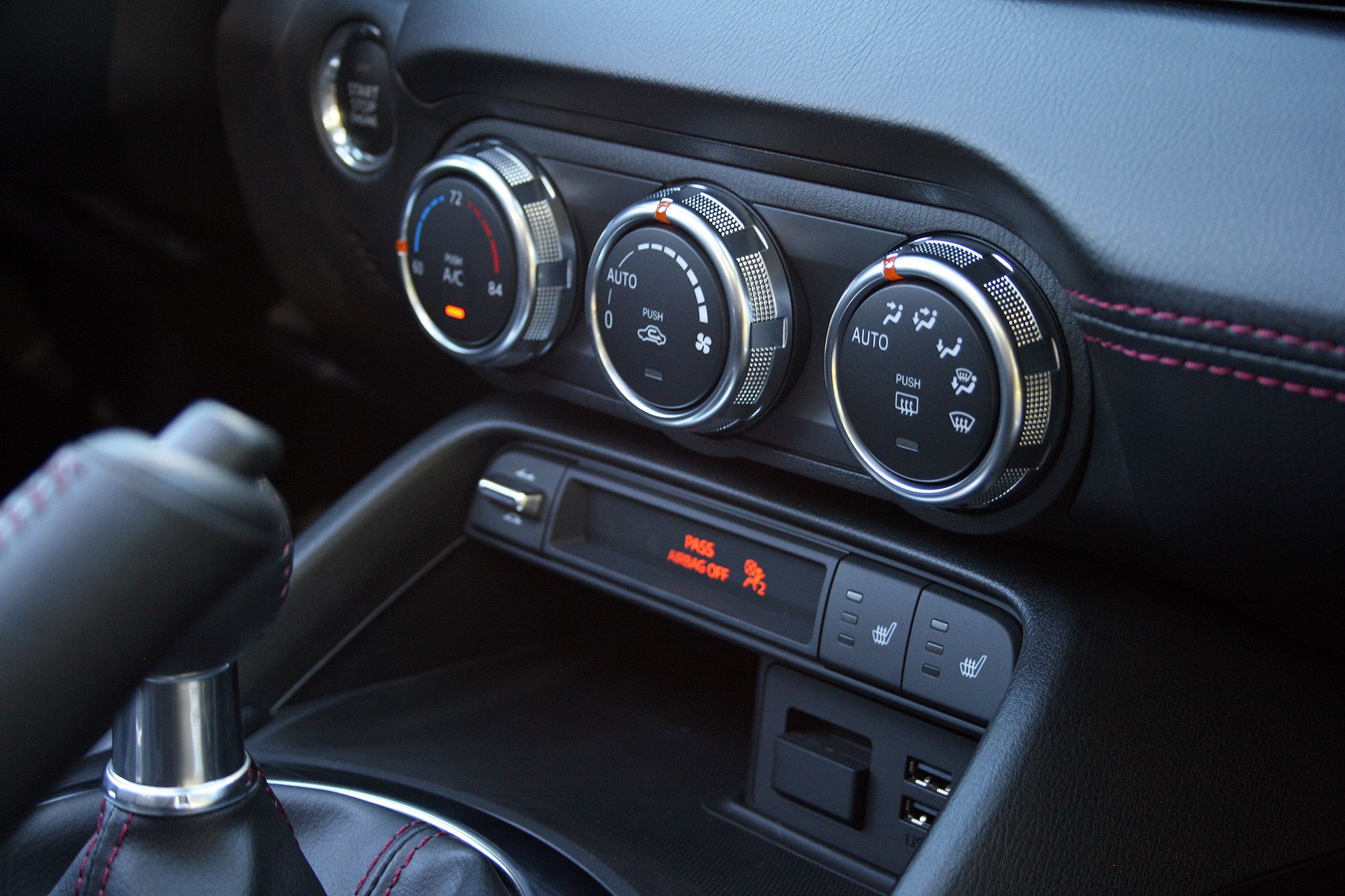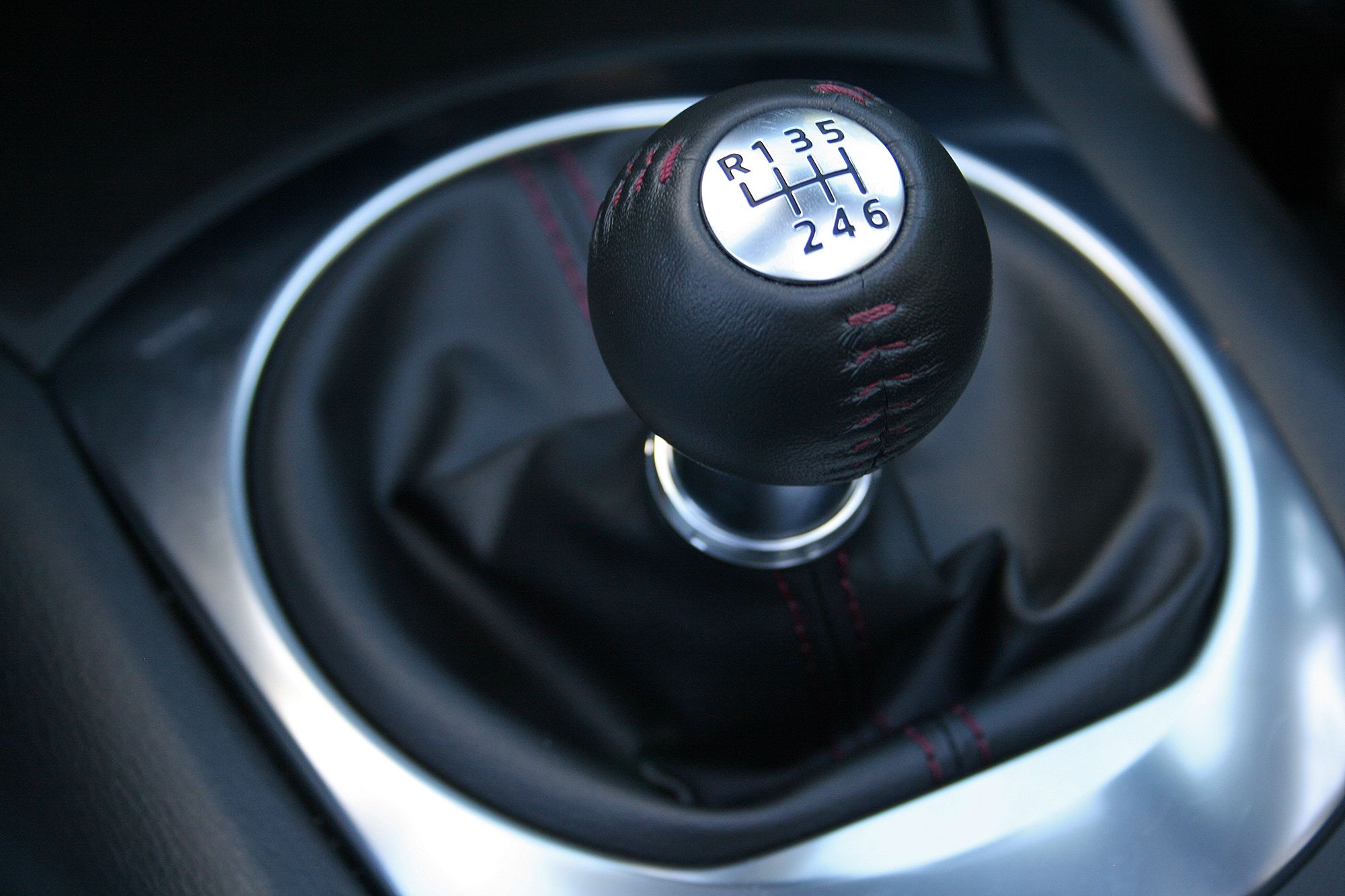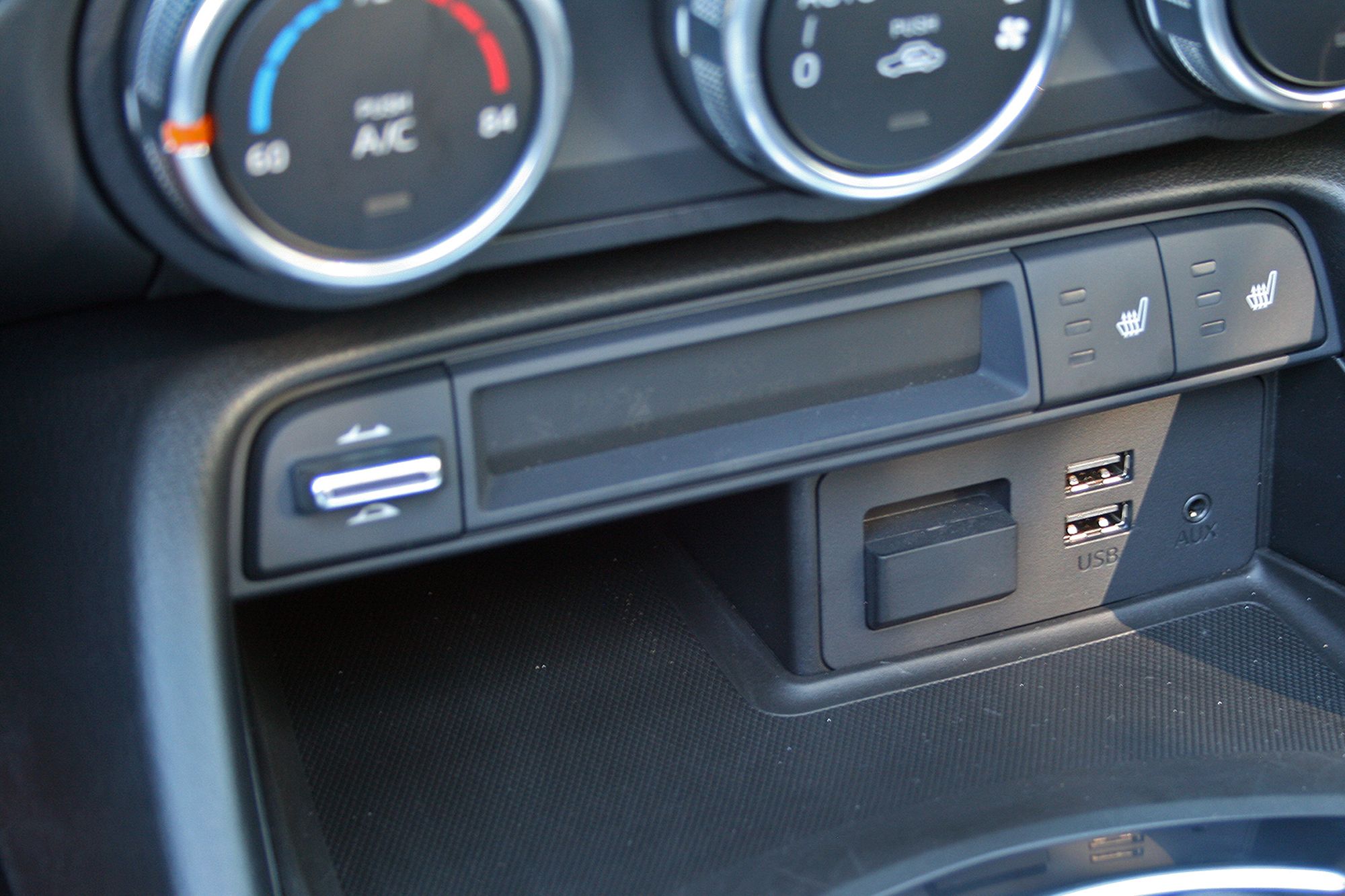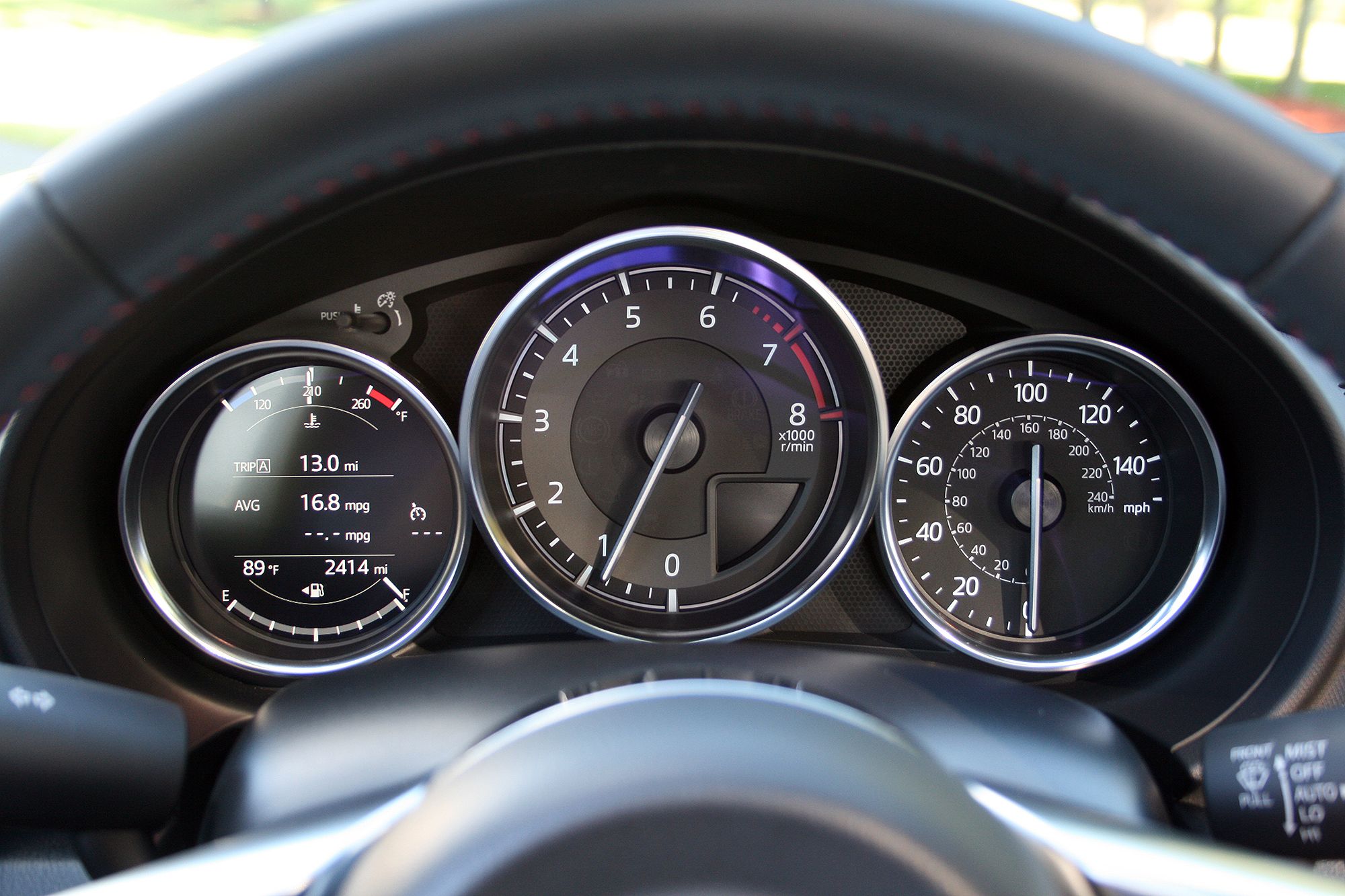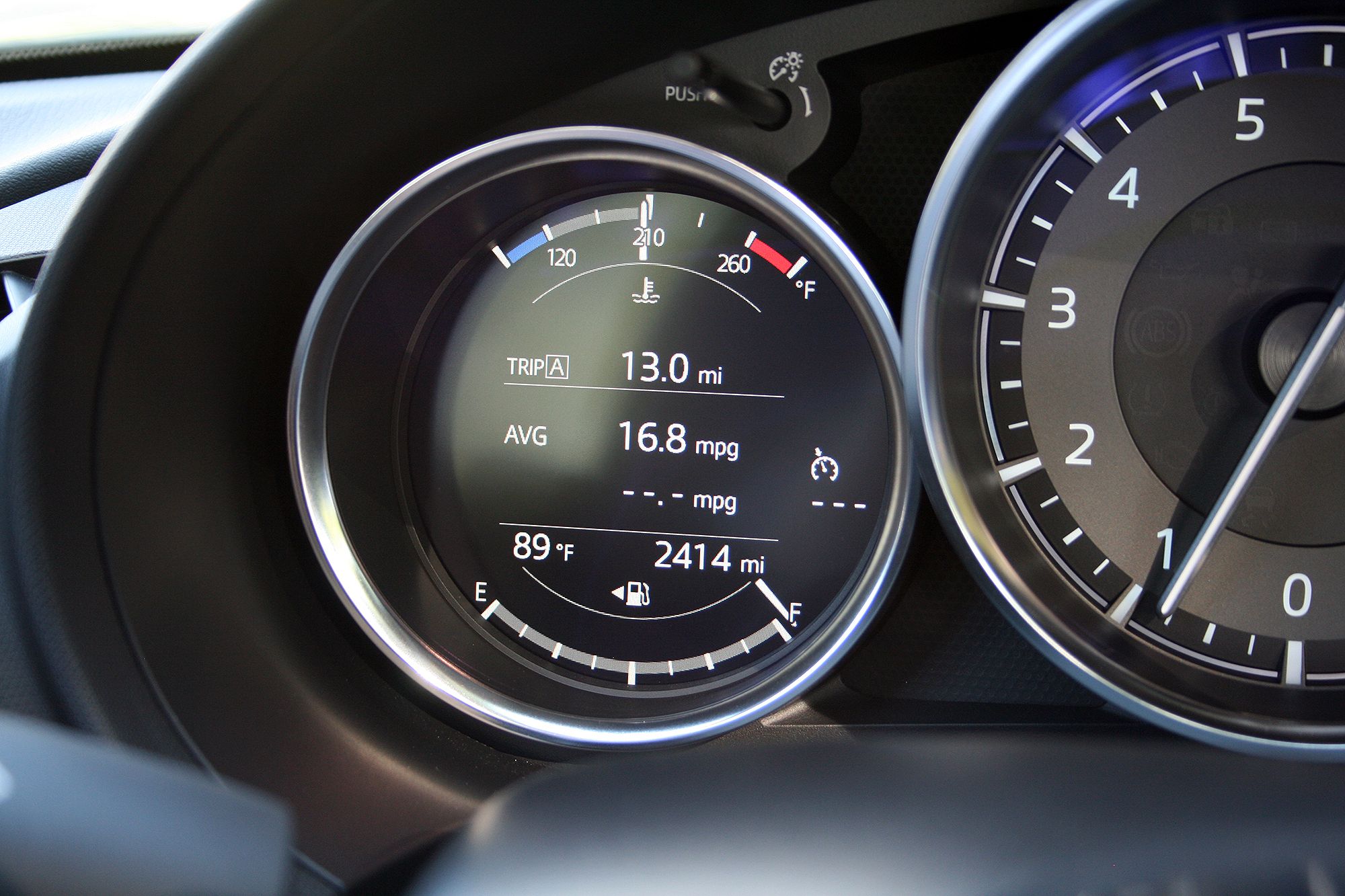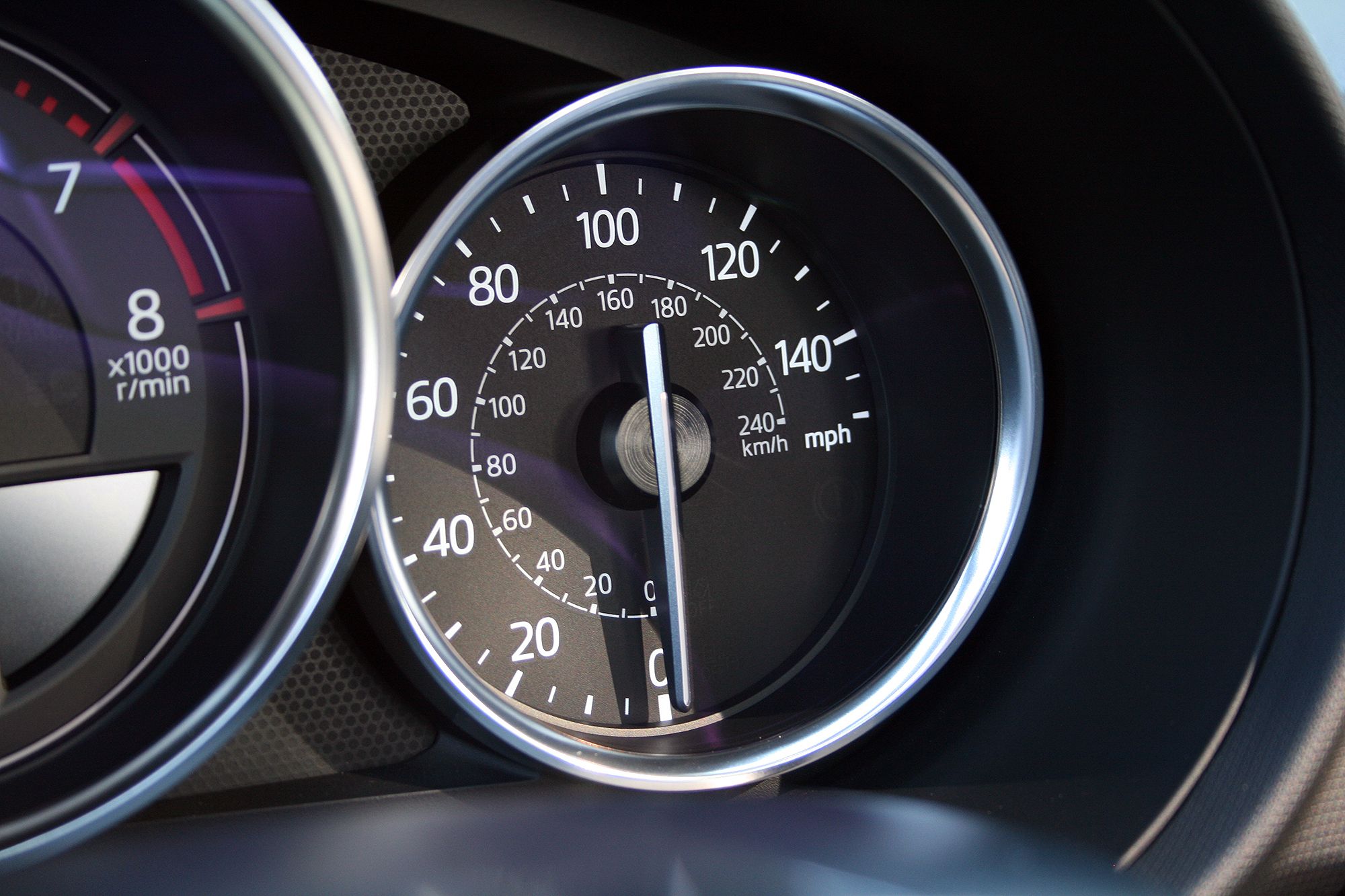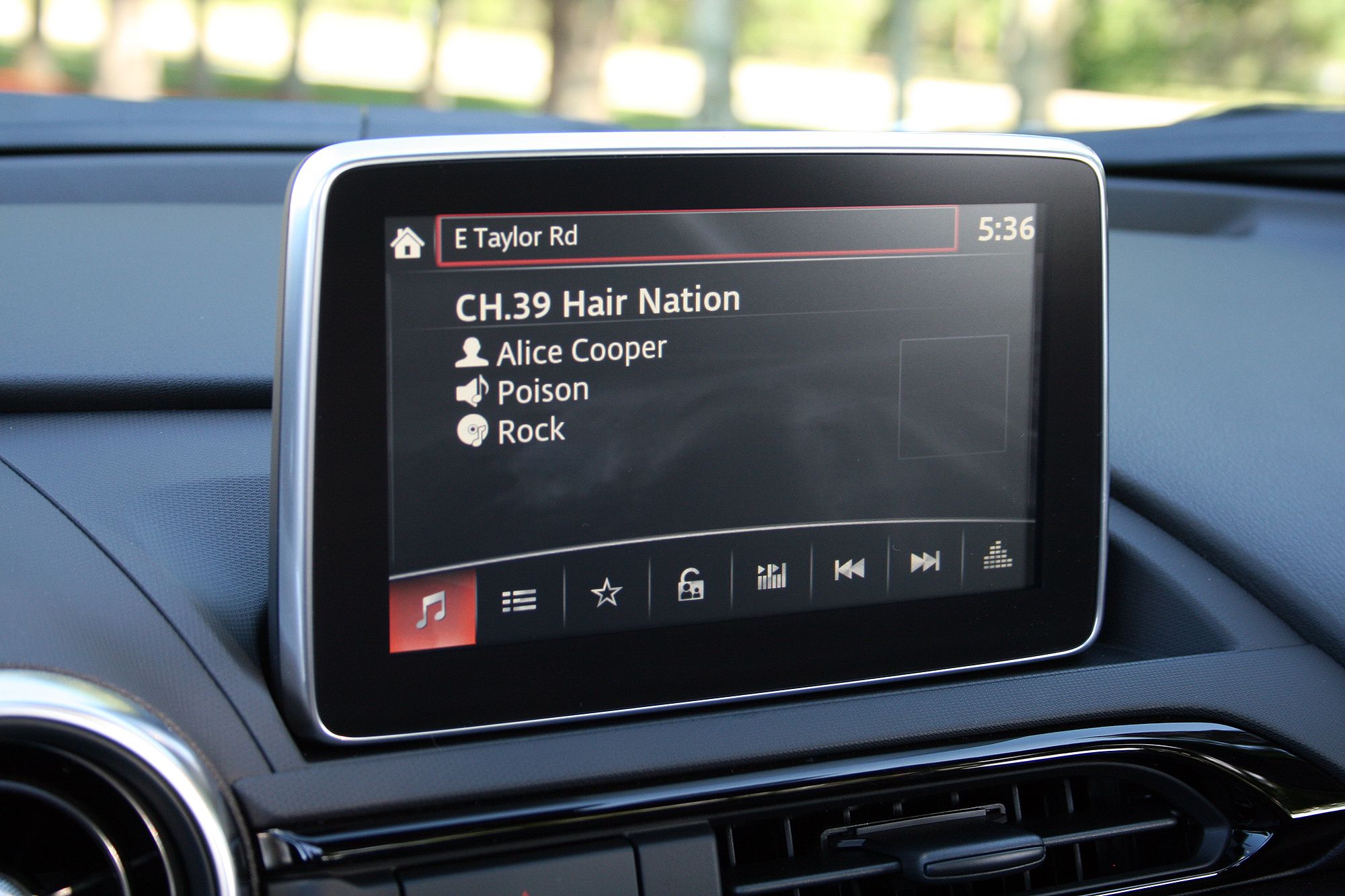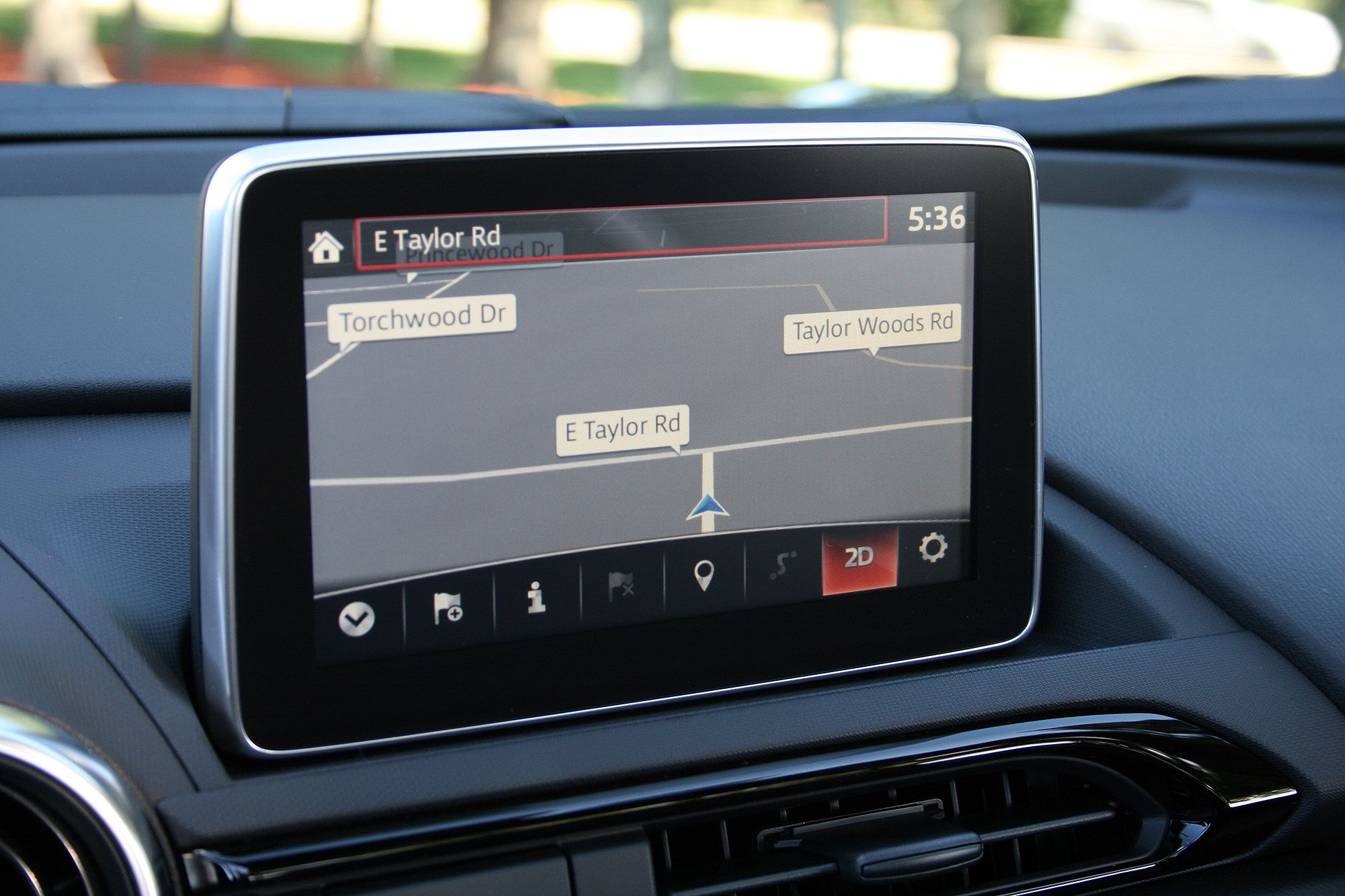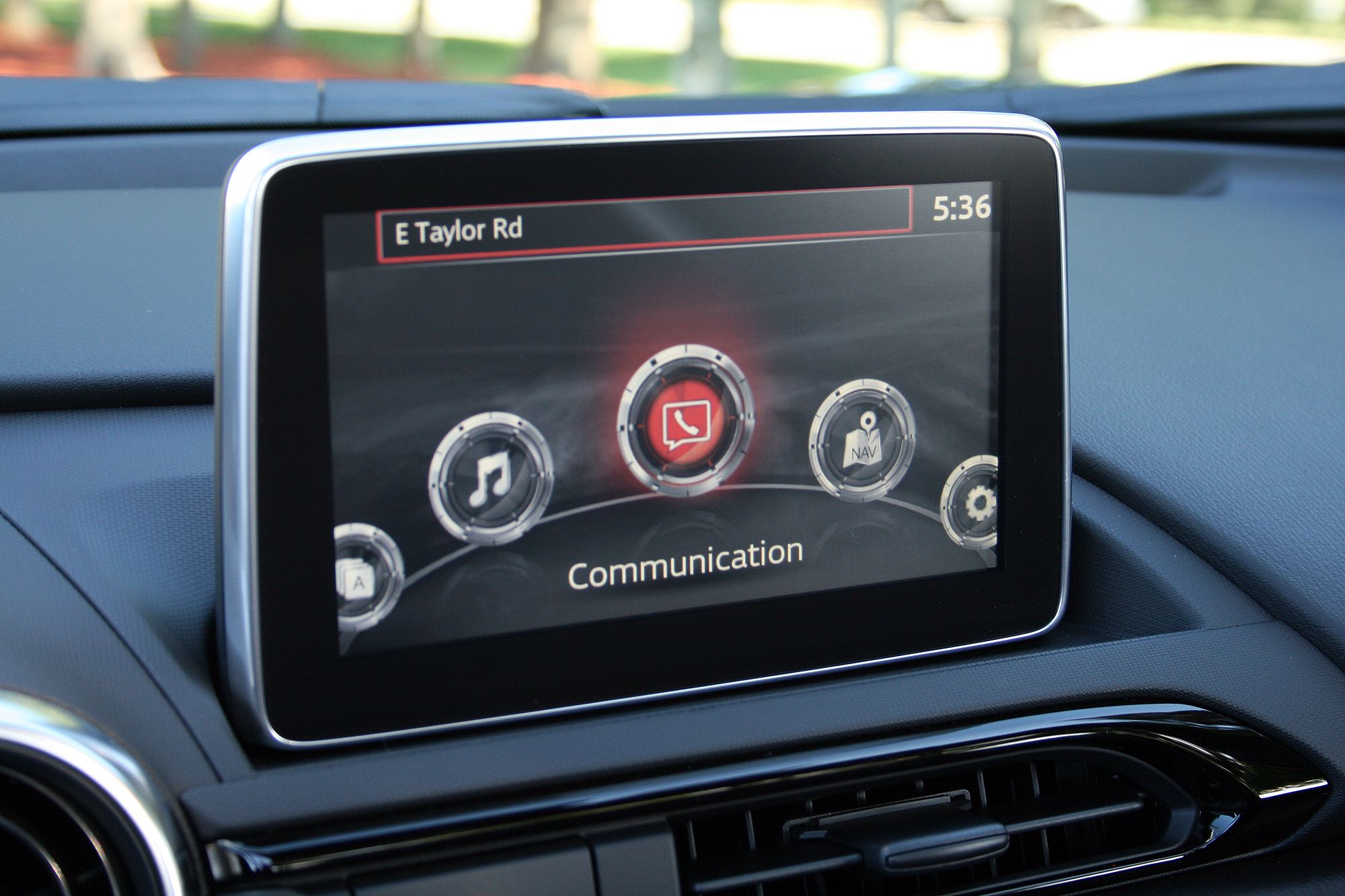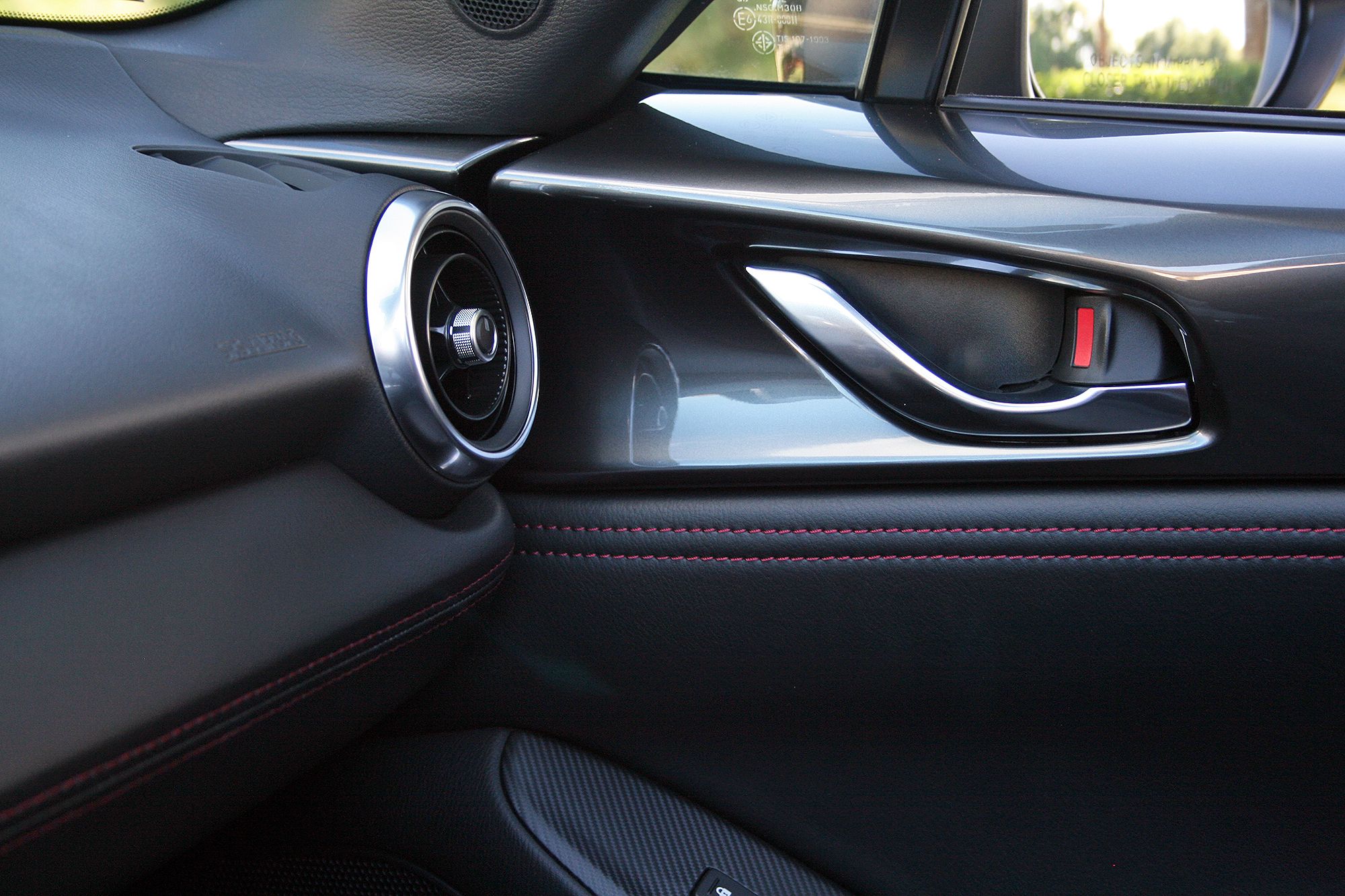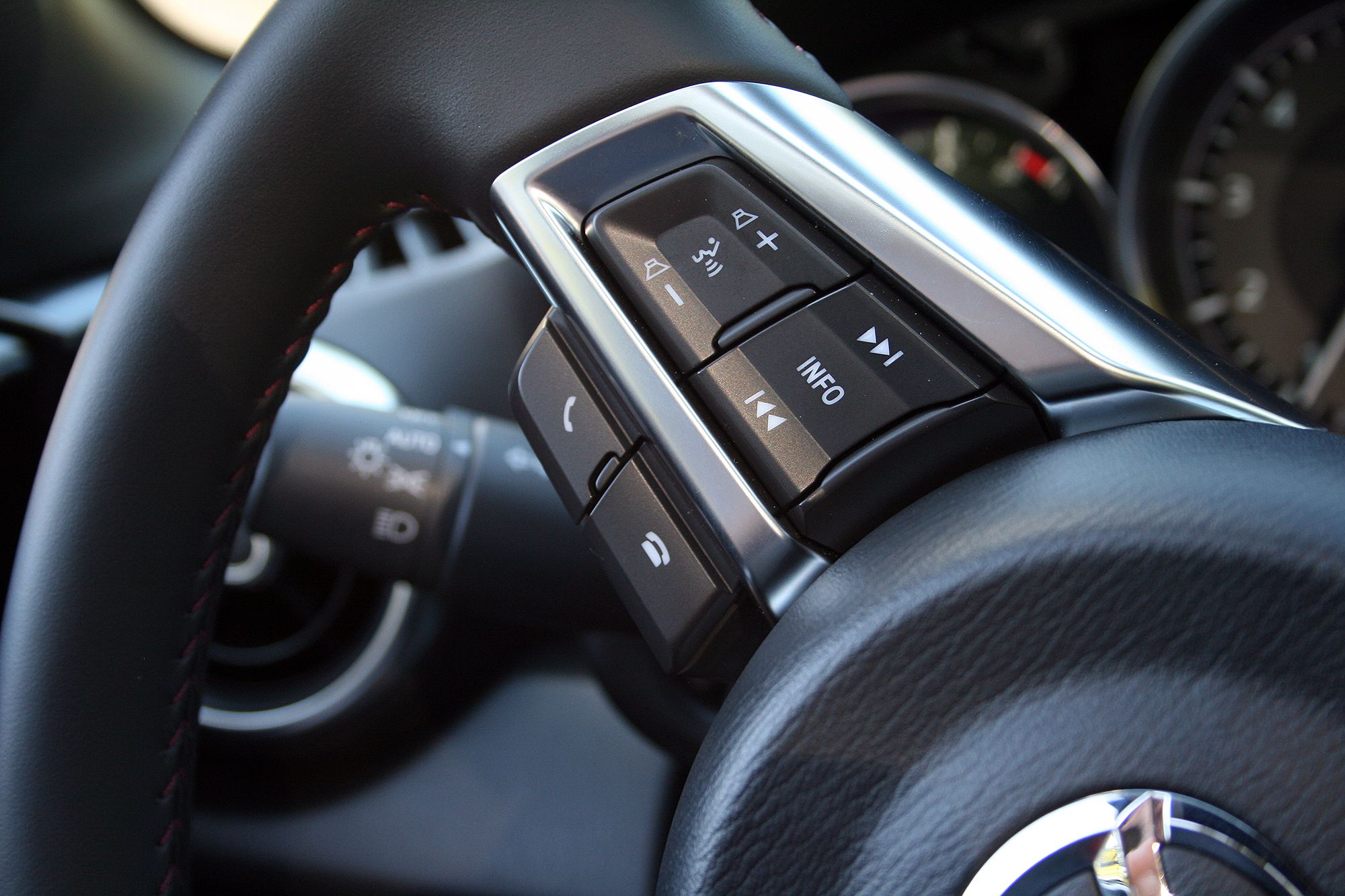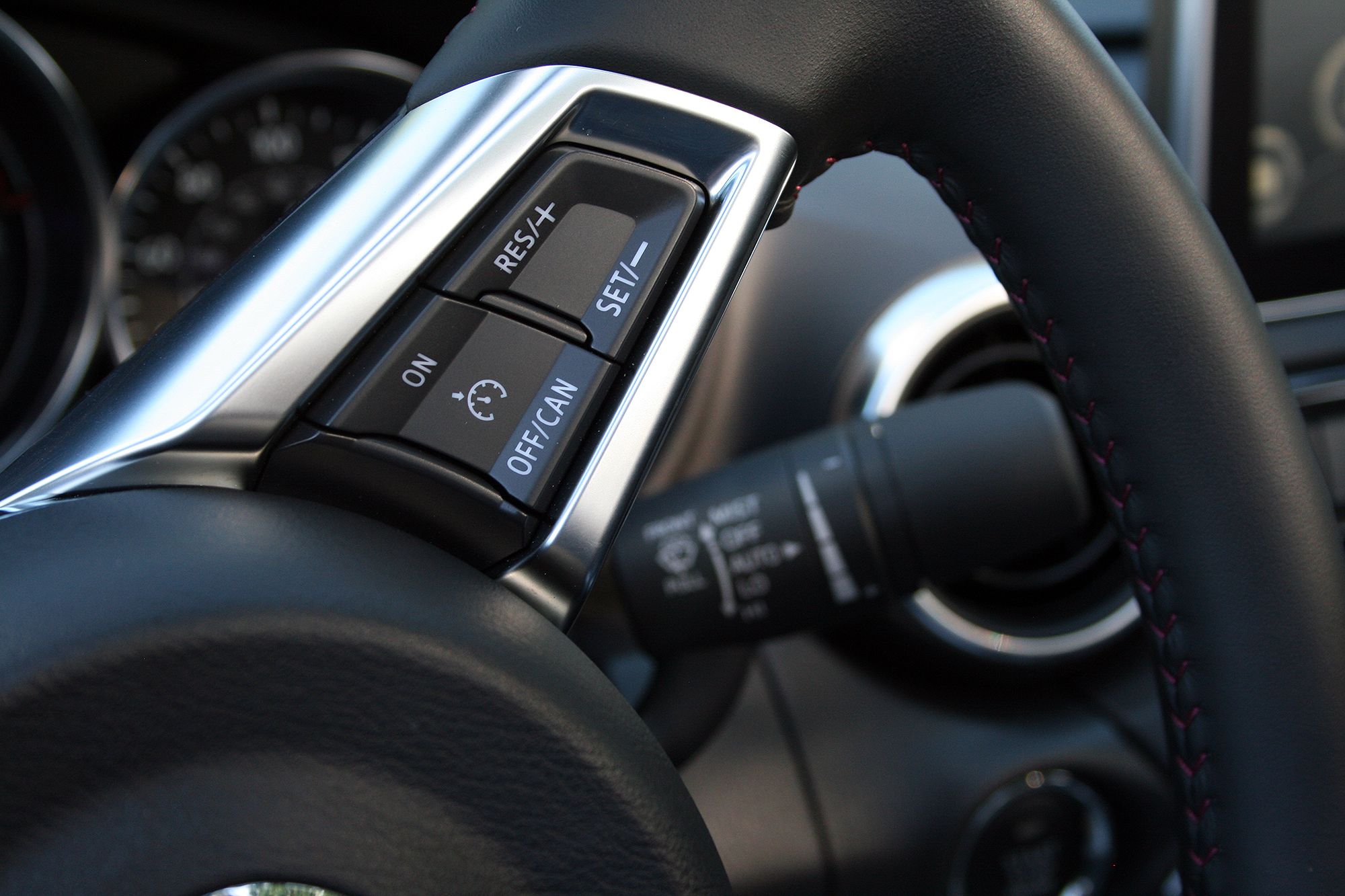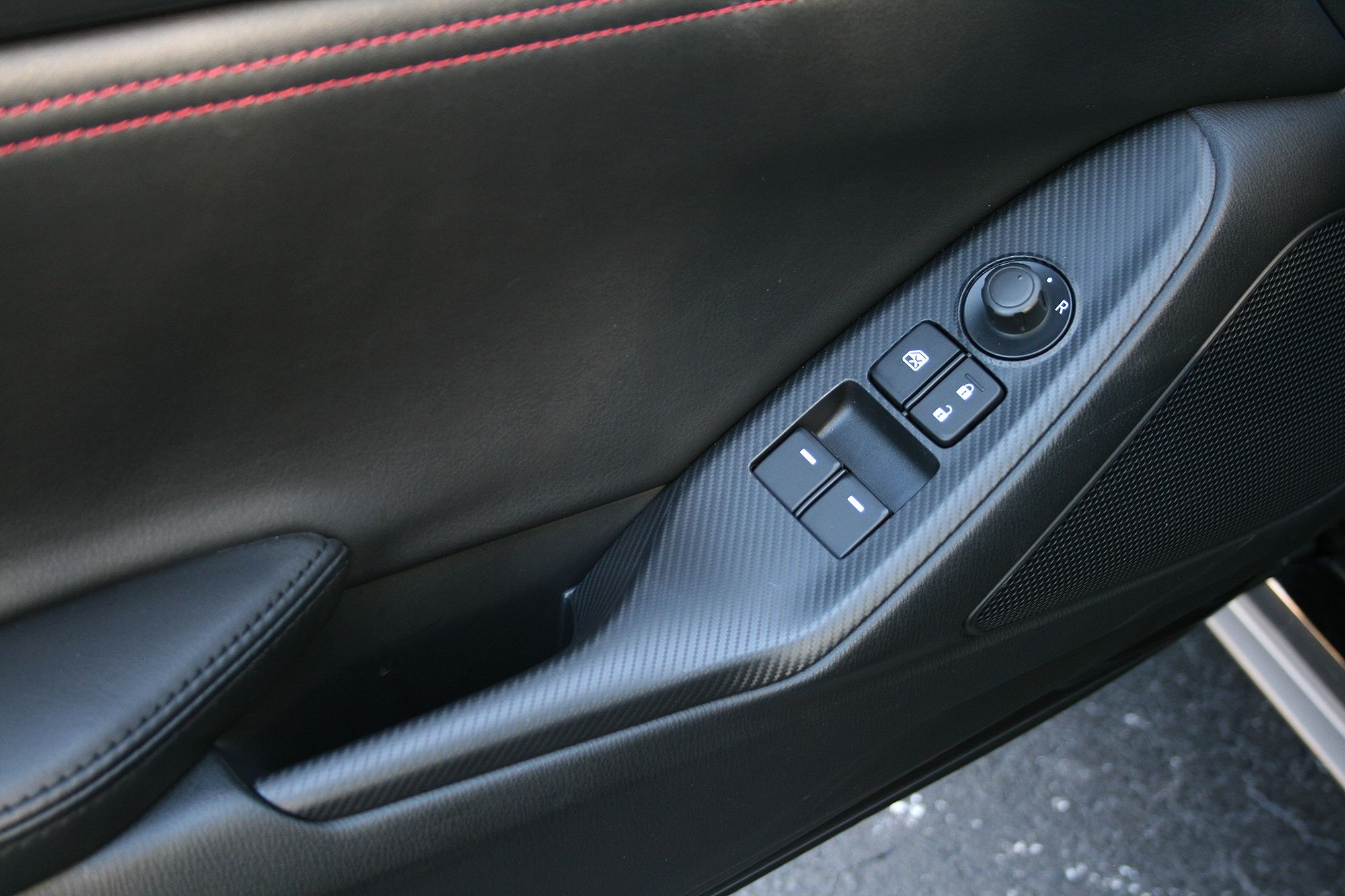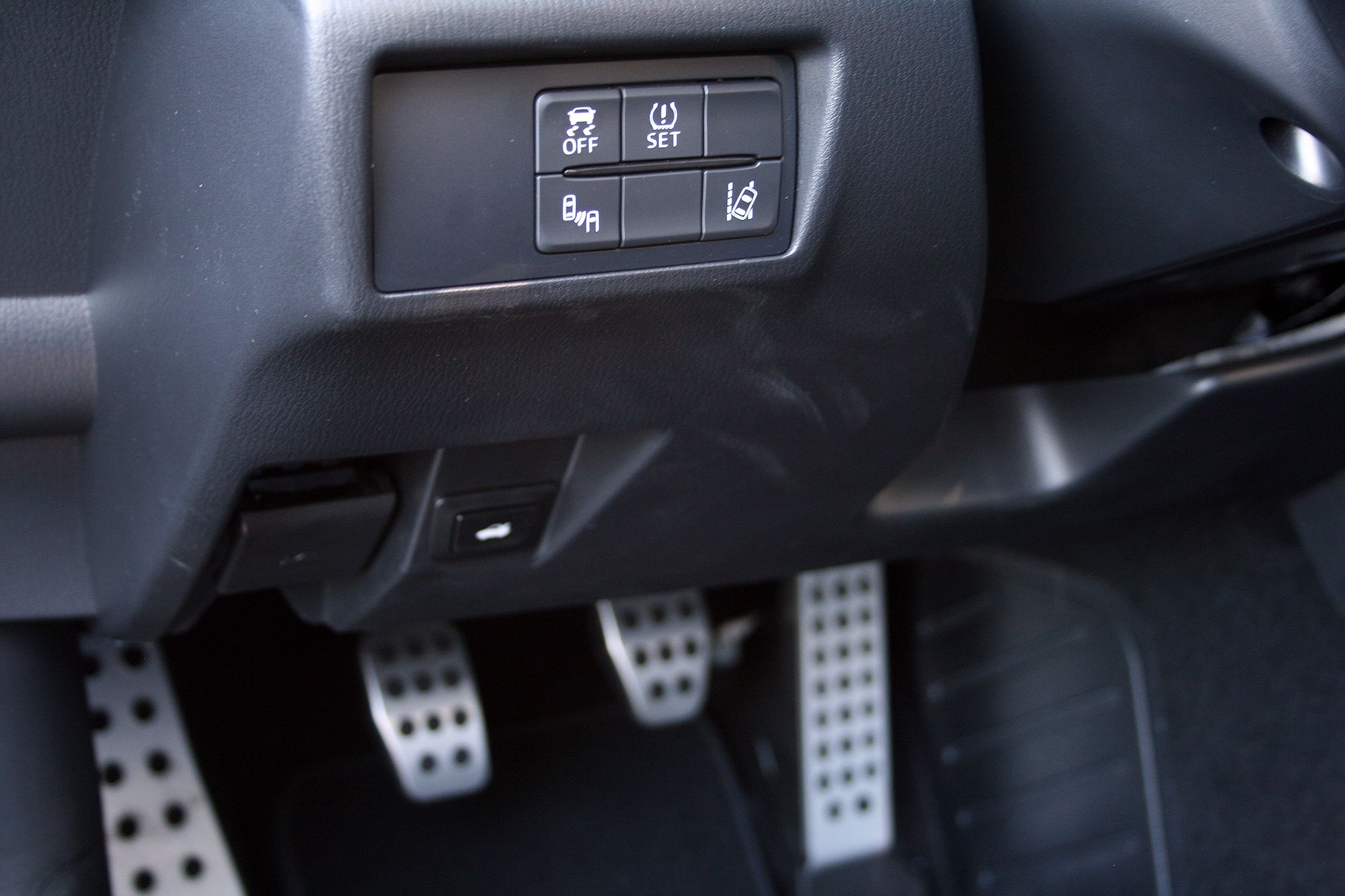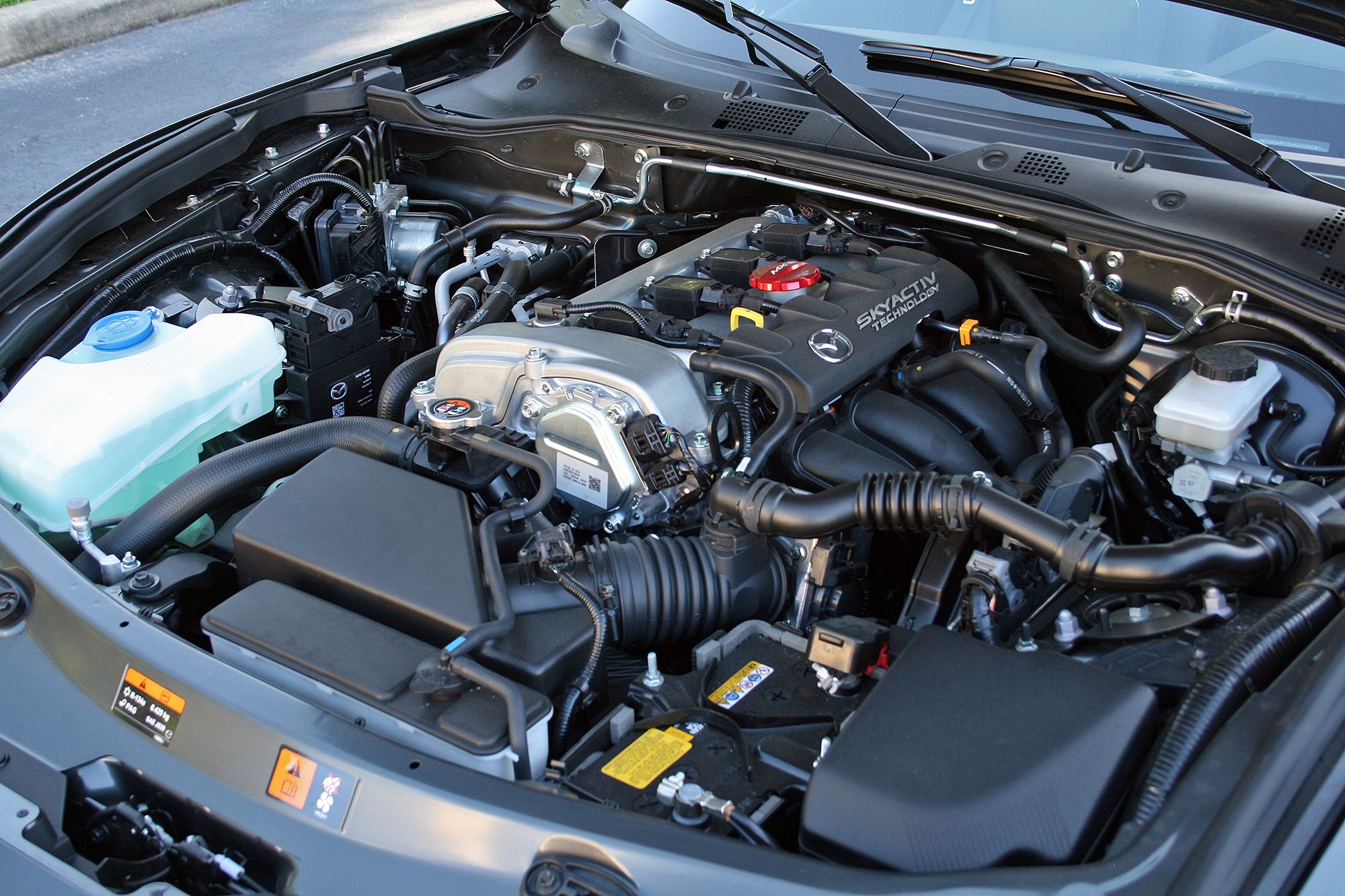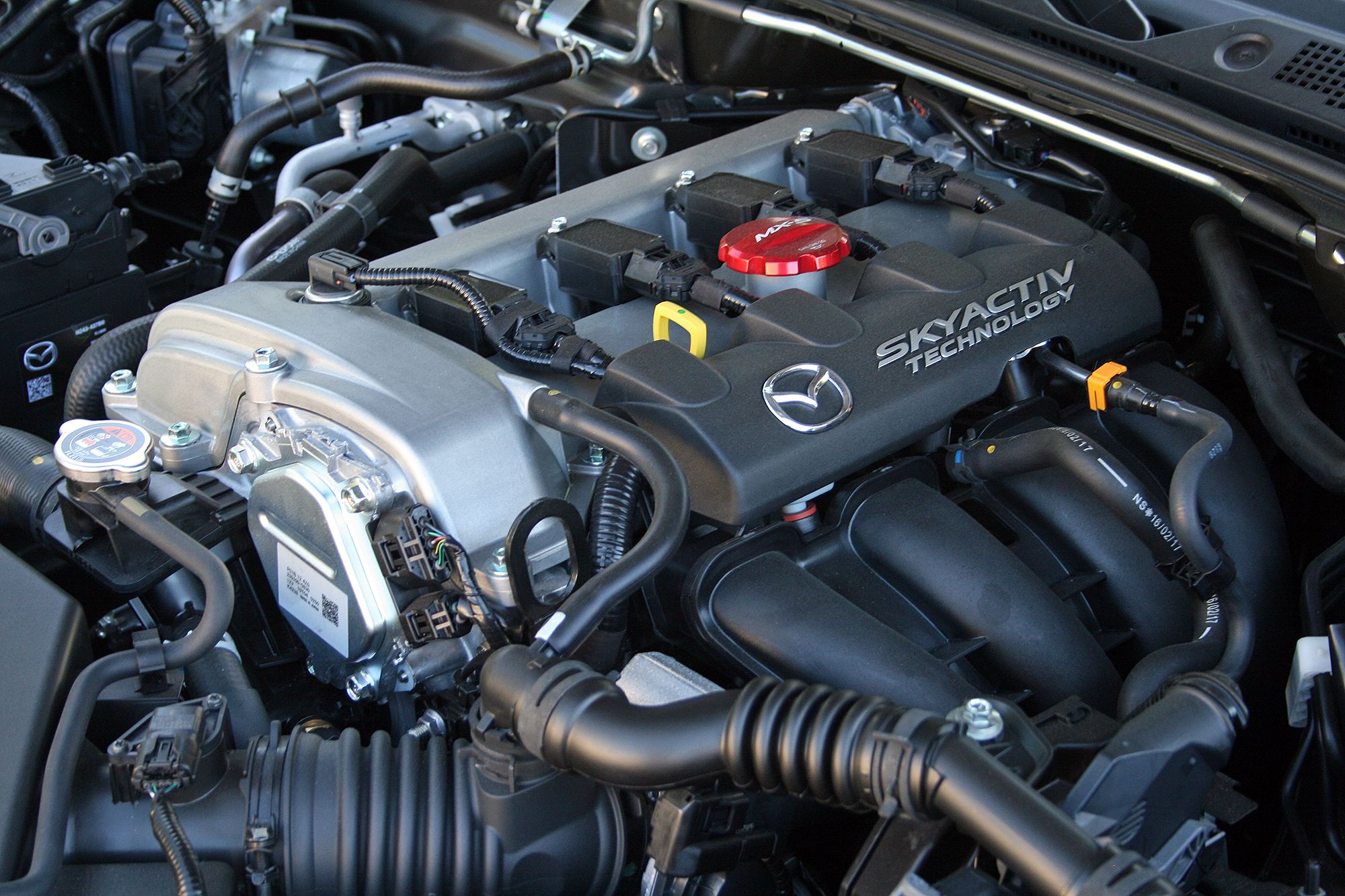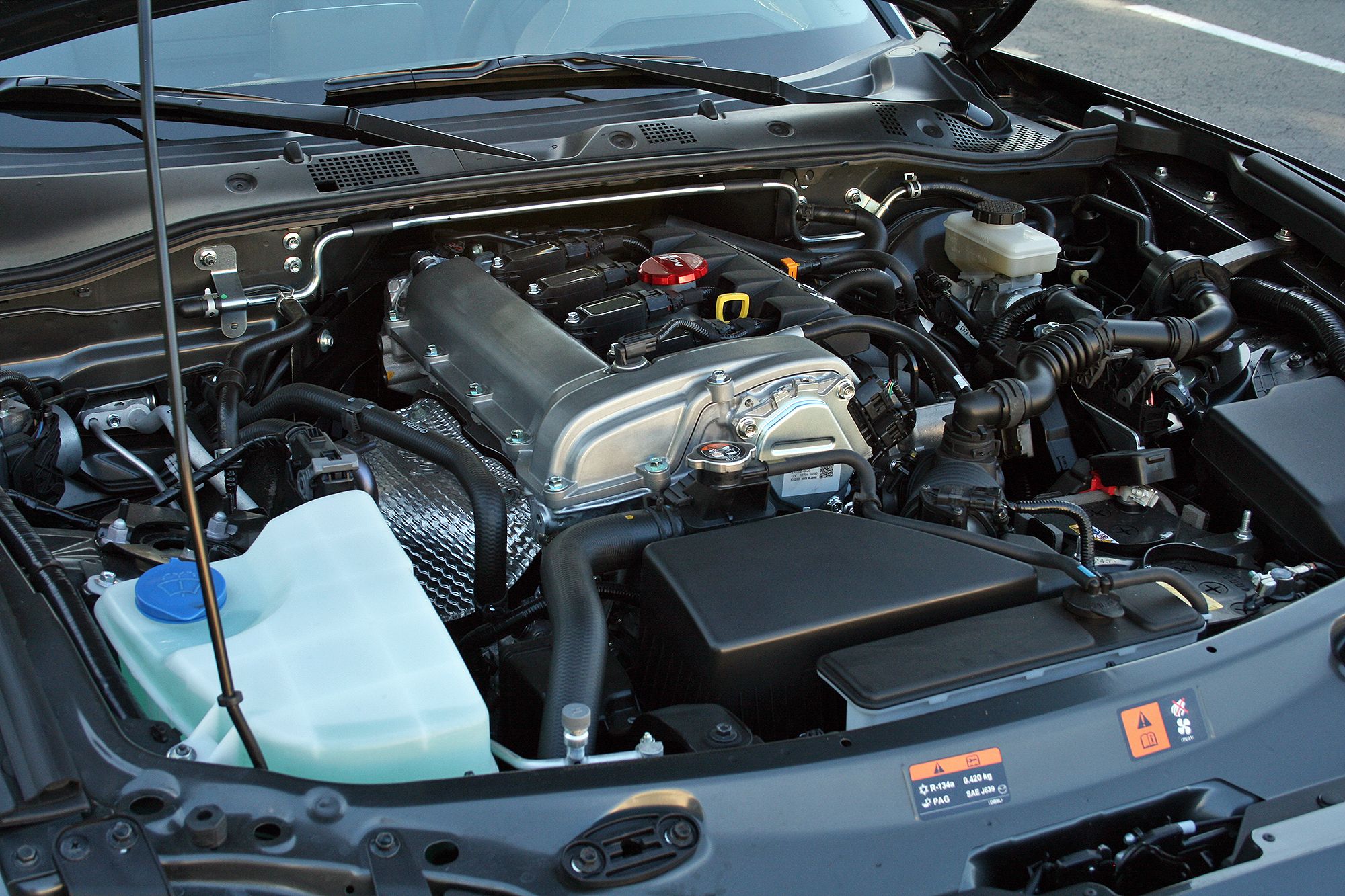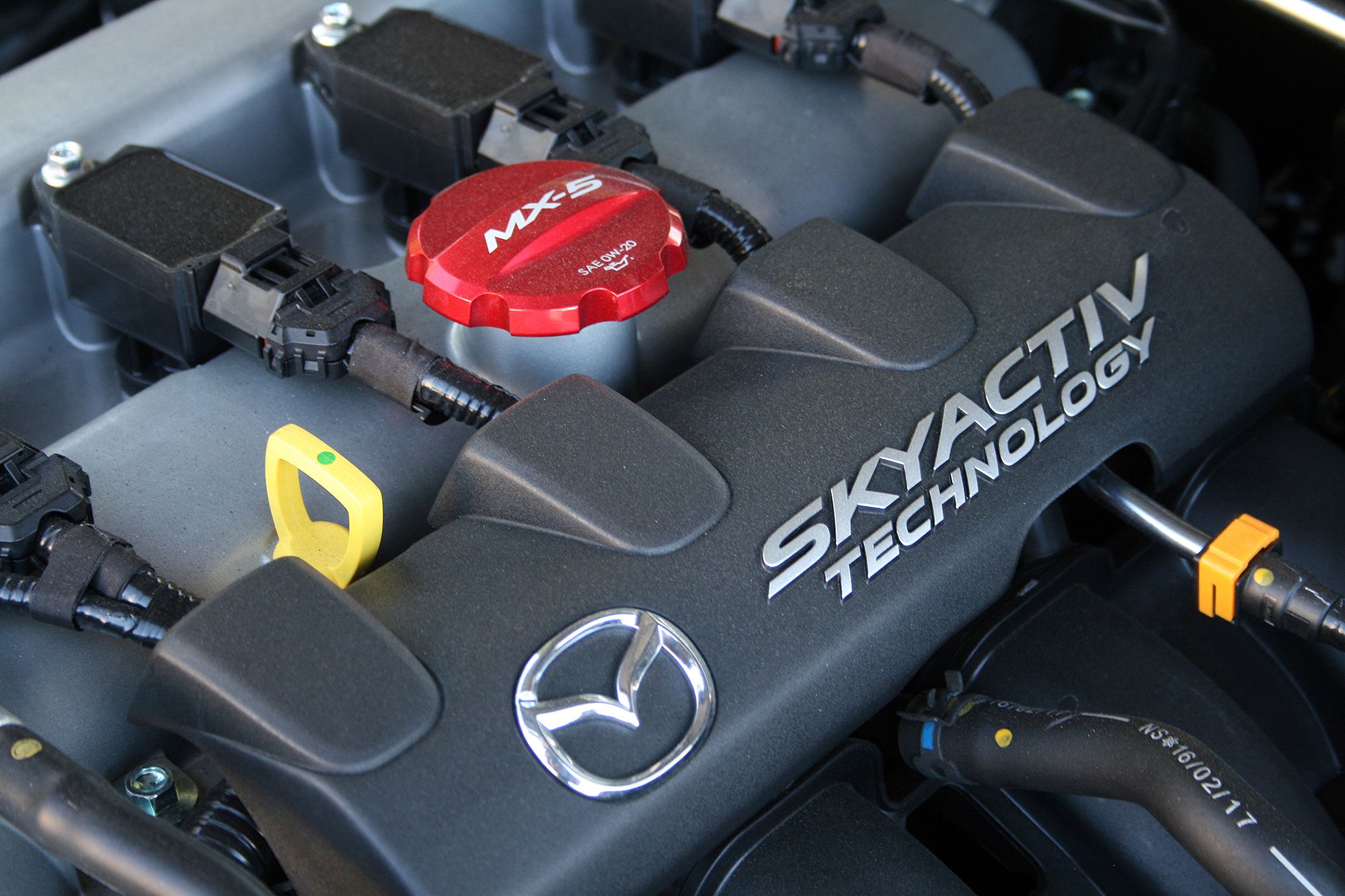Needing no introduction, the Mazda Miata RF is well into its first year of production. This retractable fastback version of Mazda’s insanely popular two-seat sports car not only adds a level of interior comfort with lower noise levels and better insulation against extreme temperatures, but also adds some beautiful aesthetics to the MX-5’s Kodo Design language. Coated in the gorgeous Machine Gray metallic paint, out recent test car proved the Miata RF is more than a mere replacement for the last-generation power-retractable hardtop.
The Miata RF is a looker. Its styling flows with more grace and elegance than the ragtop convertible. Crisp edges meet with curved fenders and voluptuous haunches. Mazda’s attention to detail moves the Miata further up-market, while its price and fun-loving nature remain firmly planted in the obtainable sports car category. Aside from the roof, the Miata RF changes little from its roadster counterpart. An extra 113 pounds, a slightly revised steering calibration, and modestly retuned suspension comprise the most notable differences. But how does this affect the drive? To find out, I spent a week with the Miata RF, flogging it over familiar roads around Central Florida, all the while enjoying the springtime air flowing through the open cockpit.
Continue reading for the full driven review.
2017 Mazda Miata RF – Driven
- Make: Array
- Model: 2017 Mazda Miata RF – Driven
- Engine/Motor: inline-4
- Horsepower: 155 @ 6000
- Torque: 148 @ 4699
- Transmission: six-speed manual
- [do not use] Vehicle Model: Array
Video Review
Exterior

|
left> 
|
Aesthetics might be subjective, but I’d say its hard not to find the Miata RF strikingly gorgeous. Its front clip is aggressively styled, with sharp lines and a purposeful stance. Its headlights seem angry, while the grille somewhat looks like the gaping month of a hungry shark. The in-your-face attitude melds into curvier and milder styling further back, taking a more reserved approach. Muscular shapes along the lower fascia on the rear bumper are still aggressive, but to a lesser degree. But this is nothing new; the current ND Miata has been around since 2016.
The big change is obviously up top. The retractable fastback adds a new dimension to the Miata – one of sophistication and complexity. The Miata RF simply seems more well-to-do. Perhaps it’s because the retractable fastback’s design somewhat resembles the Porsche 911 Targa. The two cars share commonalities, with the overarching concept of movement and packaging being rather similar. When operating, both the Miata and 911 Targa’s buttress section raises up to reveal the roof’s storage compartment. Specific to the Miata, its three-piece roof section folds and tucks away into the same space used by the soft top. Afterward, the buttress section lowers back to its original position over the B-pillars. Once complete, the roof section between the A- and B-pillars and the rear window are missing. The Porsche is a bit different in that its B-pillar and buttress are separate pieces. What’s more, the Porsche’s roof isn’t metal, but rather cloth. Nevertheless, the two share a bond.
In practice, the Miata’s roof operates in roughly 13 seconds and at speeds up to six mph. Mazda has been quoted as saying the six-mph cutoff is to mitigate the chance of long hair getting caught in the moving parts directly behind the seats. With the top in place, interior headroom is slightly compromised over the roadster, but only by a half-inch or so.
The Main Competition: Subaru BRZ
The Subaru BRZ isn’t technically an apples to apples competitor for the Mazda Miata RF, but it’s about the closest currently available in the current U.S. market. The BRZ is a 2+2 coupe that isn’t even offered with a sunroof. Still, it’s a four-cylinder, rear-wheel drive car built for handling around twisty roads. On the outside, the BRZ wears an aggressive design with a mild chin splitter, vents, fins, and a raised spoiler on the trunk. The cab-rearward design gives the BRZ a long nose, though most of the engine lives ahead of the front wheels. Dual exhaust with chrome tips, relatively large 17-inch wheels. An optional Brembo Brake Package brings big red calipers on larger rotors, along with black 17-inch wheels.
Exterior Dimensions
|
Mazda MX-5 Miata RF |
Subaru BRZ |
|
|
Wheelbase (Inches) |
90.9 |
101.2 |
|
Length (Inches) |
154.1 |
166.7 |
|
Width (Inches) |
68.3 |
69.9 |
|
Height (Inches) |
49.0 |
50.6 |
|
Track front/rear (Inches) |
58.9/59.17 |
59.8/60.6 |
Interior
Speaking of the interior, the Mazda RF remains true to the Miata roadster’s form. The interiors are identical. That’s certainly not a bad thing, as the Miata come with a beautiful cockpit with a purposeful design. I’ll give you one guess as to that purpose though. Driving, and that’s about it. Elbowroom and storage space come at a premium, making Real Estate in Manhattan seem like farmland in Tennessee. It’s clear the Miata is designed to be driven rather than lived in. But boy, does the Miata sure deliver on drivability. The ergonomics between the steering wheel, gear shifter, pedals, the seat, and the cowl are all optimized for the act of driving. Nothing inhibits the motions between these components as the car shrinks around the driver. The more confident I became behind the wheel, the smaller the car became – in a good way.
When not hooning around twisty roads, the interior’s cramped quarters begins showing. Good luck fitting a large Styrofoam cup from your favorite burger joint into the removable cup holders. A small storage bin lives under the center armrest, but is barely large enough to fit a wallet. There is no glovebox either, at least not in the traditional sense. A small cubby between the seats provides the most storage, but half its volume is consumed by the owners manual. A small slot ahead of the gear shifter provides space for a standard-size cell phone. Thankfully, Mazda does provide two USB ports for charging.
Creature comforts include three-position heated seats. They’re only available in the Grand Touring trim, which my tester was, and offer an intense heat on the highest setting. My in-house heated seat tester, aka my wife, says the heaters work extremely well and generate warmth well up the backrest. I found the leatherette seats to be hot even with the heaters turned off, leaving me with a sweaty back and a deep desire for vented seats.
Trunk space is another issue. It measures only 4.6 cubic inches, meaning it’s smaller than the front trunk of the Tesla Model S. While a couple carry-on bags will fit, don’t plan on buying in bulk at the local big-box store. Nevertheless, I am impressed the truck remains uncompromised from the additional hard top mechanics. Best of all, the trunk is seal from the top, meaning your luggage runs no risk of getting crushed.
Inside the Subaru BRZ
The BRZ isn’t as refines as the Miata, both outside and in. The Subi’s boy-racer appearance continues to the interior where faux carbon fiber, an abundance of contrast stitching, and heavily bolster seats make the coupe feel like a track car. Comparatively, the Miata is more refined thanks to a more reserved and tasteful interior with leatherette instead of suede covering the seats. While there is plenty of contrast stitching in the Miata, Mazda designers chose a more subtle hue. Of course, the BRZ’s biggest advantage is interior space. The back seats aren’t suitable for full-size adults, but they work fine for kids or in a pinch. The trunk is also larger, at 6.9 cubic feet, and the rear seats fold flat for larger items. Even the cup holders are more secure, though are still hard to reach. Those wanting an easy-going grand touring car with a fun attitude should look to the Miata. The BRZ is always on the brash side, even when driven gently.
Interior Dimensions
|
Mazda MX-5 Miata RF |
Subaru BRZ |
||
|
Mazda MX-5 Miata RF |
Subaru BRZ |
36.8/N/A |
37.1/35.0 |
|
Headroom front/rear (Inches) |
43.1/N/A |
41.9/29.9 |
|
|
Leg room front/rear (Inches) |
52.2/N/A |
54.5/51.7 |
|
|
Shoulder room front/rear (Inches) |
52.0/N/A |
53.1/45.3 |
|
|
Hip room front/rear (Inches) |
4.48 |
6.9 |
Drivetrain
The Miata RF is undeniably a sports car in every sense of the term, but its horsepower rating might come as a surprise. Like the generations before it, the Miata is not overpowered, but rather uses its lightweight chassis and small footprint to its advantage. Under the hood is a 2.0-liter four-cylinder. This naturally aspirated, all-aluminum mill generates 155 horsepower at 6,000 rpm and 148 pound-feet of torque at 4,600 rpm. That doesn’t sound like much, but considering the Miata only weights 2,400 pounds, it’s just enough to make the Mazda zoom zoom. The sprint to 60 mph takes 6.5 seconds and it will finish the quarter-mile in around 15 seconds. Its top speed is 135 mph. Again, not crazy numbers, but the Miata has never been about breaking drag strip records.
A six-speed automatic transmission is offered at extra charge, but you’d be foolish to option it. The proper choice (and included in the price) is the six-speed manual. Many argue that Mazda has perfected the manual gearbox, and I’d have to agree. The Miata’s shifts are somehow butter smooth yet crisp and direct. The short throws require little effort and the narrow shift gates make for quick action. Just don’t miss that 4-5 upshift and go into third. Thankfully, I’m not speaking from experience, but the possibility seems extremely real. The clutch is equally rewarding to operate thanks to a smooth, light travel and tactile engagement. It’s easy to nail perfect shifts every time. And thanks to the engine’s free-revving nature, perfectly matched downshifts come without thought.
Sadly for the Grand Sport trim, Mazda doesn’t offer the limited-slip differential that comes standard in the manual-equipped Club model. Though most folks who aren’t driving around a road course will be just fine, more serious drivers will want the torque-sensing limited-slip and the extra traction it provides. Still, I drove fairly hard over the week, and never experienced any issues on public roads.
And aside from being a great sports car, the Miata is rather frugal to drive. It does require premium fuel, but it gets an EPA-estimated 26 mpg city, 33 mpg highway, and 29 mpg combined. Over the week, I averaged right at 29.9 in mixed driving.
Subaru’s Boxer Engine
The BRZ’s 2.0-liter Boxer four-cylinder has undergone some deep updates for 2017 for better breathing and less internal friction. It has a new aluminum intake manifold, a new exhaust with better flow, high-polished wear surfaces on the valvetrain and camshafts, and new programming for the direct fuel injection system. Sadly, these changes only net a gain of five horsepower and pound-feet of torque, and are only available with manual-transmission models. Total power is 205 horsepower at 7,000 rpm and 156 pound-feet of torque at 6,400 rpm. That’s not bad considering the BRZ only weights 2,800 pounds – roughly 400 pounds more than the Miata RF. The fairly equal power-to-weight ratio means the BRZ accelerates to 60 mph in roughly the same time, estimated between 6.2 and 6.5 seconds.
Drivetrain Specifications
|
Mazda MX-5 Miata RF |
Subaru BRZ |
||
|
Mazda MX-5 Miata RF |
Subaru BRZ |
SKYACTIV-G 2.0L DOHC 16-valve 4-cylinder with VVT |
2.0-liter 4-cylinder, horizontally opposed |
|
Engine |
155 HP @ 6,000 RPM |
205 HP @ 7,000 RPM |
|
|
Horsepower |
148 LB-FT @ 4,600 RPM |
156 LB-FT @ 6,400 RPM |
|
|
Torque |
6-speed manual |
6-speed manual |
|
|
Transmission |
2,445 Lbs |
2,785 Lbs |
|
|
Curb weight |
26/33 |
21/29 |
|
|
Fuel economy city/highway |
6.5 seconds |
6.2-6.5 seconds |
|
|
0 to 60 mph |
135 mph |
143 mph |
Behind the Wheel
The Miata RF is therapy for the driving enthusiast. Its character on the road is pure-intentioned and well behaved yet it delivers a swift serving of excitement. It’s like the perfect date – they are safe and won’t smash your heart to bits, but they’re smokin’ hot and are a blast to be around. The only issue: this date is only fun on the weekends and after work because they’re a little hard to live with on the daily. But you want to live it up, because hell yeah, you’re young and fun and you’ll never trade her for a crossover when things get serious. Right? right??
Jokes aside, the Miata RF is an absolute wonder to drive. Its balanced nature and near 50/50 weight distribution combine with the finger-tip steering and silky shifter to give an unforgettable experience. Drop the top and you’ll never have been so overjoyed to drive 55 mph. Back-road speeds is where the Miata RF feels most at home. Sure, it will cruise the interstate just fine, but who finds that a thrilling ride? You’ll also enjoy the visibility out the cockpit, save for the rear quarter view, making it the perfect car for roads like the Smoky Mountain’s Tail of the Dragon.
Driving the Subaru BRZ
Behind the wheel of the slightly improved 2017 BRZ, the Subaru proves its build for fun and doing it all the time. Even when putting along, the BRZ feels like its driving 7/10ths. Its Boxer engine fills the cabin with a raspy, buzzy noise, while the stiff suspension translates every imperfection in the road through the lightly padded bucket seats. Your grandmother wouldn’t appreciate a ride in your cute little car. But all these attributes are exactly what’s desired in a track-capable coupe.
The BRZ holds its own very well when pushed hard. The skinny tires are its weak point, making the car feel squirrelier than its well-balanced chassis deserves. A set of sticky summer tires would miracles. And like the Miata, the BRZ isn’t a straight-line monster. This is a machine for carving canyon roads.
Pricing
The 2017 Miata convertible in the base Sport trim is rather obtainable. It starts at $24,915. However, if you want the Miata RF, you’ll have to shell out $6,640 more. Not only does the roof add cost, but the Miata RF is not offered in the Sport trim. Apples to apples, the convertible Club starts at $28,800 while the RF Club starts at $31,555 – only $2,755 more. Opting for the automatic transmission in the RF Club only costs $730, but a whopping $1,205 in the Grand Touring. No worries though, because you won’t pansy out and get the automatic.
My tester, fitted with the range-topping Grand Touring trim, starts at $32,620. Few options were added, but definitely added nice touches. They include the $300 Machine Gray Metallic paint, the $120 keyless entry system, and the $425 Interior Package for M/T, which includes alloy pedals, door sill trim plates, and an aluminum oil cap on the engine. Add to that the $835 destination fee, and the grand total comes to $34,310.
|
Mazda Miata RF CLUB manual |
$31,555 |
|
Mazda Miata RF CLUB automatic |
$32,285 |
|
Mazda Miata RF GRAND TOURING manual |
32,620 |
|
Mazda Miata RF GRAND TOURING automatic |
$33,825 |
|
Mazda Miata RF RF LAUNCH EDITION SV manual |
$33,720 |
|
Mazda Miata RF RF LAUNCH EDITION SV automatic |
$34,925 |
Pricing for the 2017 Subaru BRZ
The 2017 Subaru BRZ comes in two trim levels: the Premium and Limited. The Premium starts at $25,495, while the better-equipped Limited starts at $27,645. The Limited brings features like the Alcantara and Leather seats, keyless access and push-button starting, and dual-zone climate controls. A notable option includes the $1,195 Performance Package with Brembo brakes and half-inch-wider 17-inch wheels. It also comes with upgrade Sachs dampers for better cornering control.
The Competition
Fiat 124 Spider
Perhaps the only true competitor to the Mazda Miata is its corporate cousin, the Fiat 124 Spider. Born in the same development center, the pair shares many of the same chassis components and ancillary bits. Even much of the interior is shared between the two. The big difference lies under the hood. The Fiat foregoes Mazda’s Skyactive 2.0-liter for its in-house 1.4-liter turbocharged four-cylinder. This is the same engine found powering the insanely fun Fiat 500 Abarth. Sadly, the brutish exhaust note doesn’t make the transition, even in the 124 Abarth. Still, the 124 makes more power than the Miata at 160 horsepower and 184 pound-feet of torque. The Abarth model gets four more horsepower.
Aside from the range-topping and sport-minded Abarth model, the 124 comes in the base Classica trim and luxury minded Lusso trim. The Lusso would be the proper competitor to the Miata Grand Touring trim, thanks to its leather seats and navigation. Still, the Fiat is not offered with the retractable fastback, leaving the Miata RF in a class of its own. Prices for the Fiat 124 Spider start at $24,995 for the Classica trim. The Lusso starts at $27,495 and the sporty Abarth starts at $28,195. Interestingly, the Lusso trim does not come standard with the same equipment found in the Miata Grand Touring. You’d need to select the $3,795 Premium Collection with Sirius package in order to get the nine-speaker Bose sound system, adaptive front headlights, auto-dimming mirrors, automatic headlights with leveling, and blind spot monitoring – all of which are included in the Miata Grand Touring. With that box checked, the Fiat 124 Spider Lusso is priced at $31,785.
Find out more about the Fiat 124 Spider here.
Conclusion
It’s clear the retractable fastback hasn’t quenched the Miata’s flair for driving, or as Mazda calls it, jinba-ittai. Translated from Japanese, the phrase literally means “horse and rider as one.” The term dates back to skilled warriors who shot arrows from a moving horse. Though the Miata RF isn’t intended for modern-day drive-bys, the premise of the driver and car acting as a single unit remains. The concept translates into reality rather well, making the driver feel connected to the car and more confident to throw it around. Having fun is the Miata RF’s forte.
It’s too bad, then, the Miata is rather unsuitable as an average American’s sole mode of transportation. Its interior and cargo space are simply too limited. Still, if I had extra cash floating around and wanted a weekend toy, the Miata would be high on my short list. It's smooth yet peppy dynamics are simplly class-leading.

